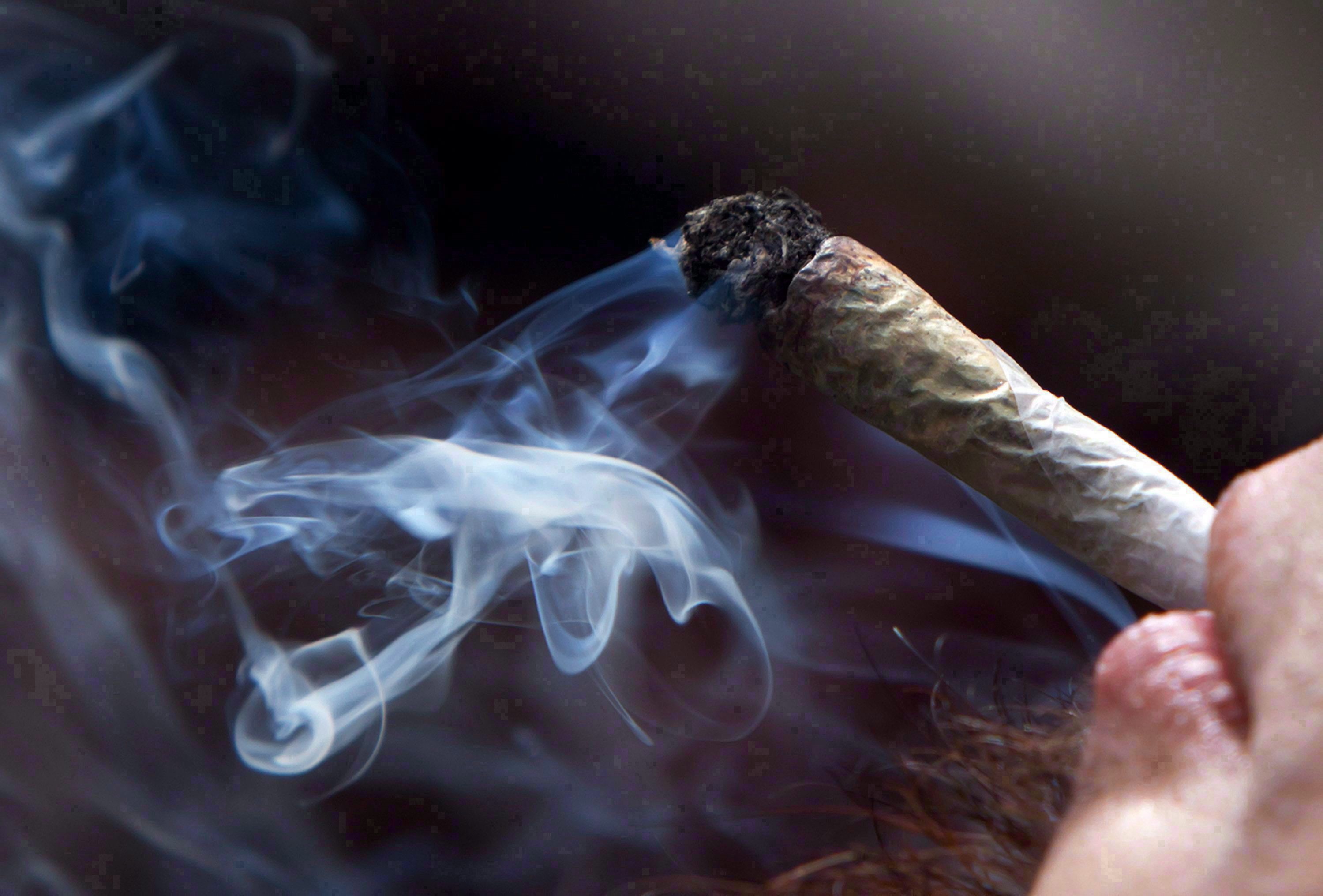Symptoms from smoking. Overcoming the Challenges of Quitting Smoking: A Comprehensive Guide
Discover what to expect when you quit smoking. Explore common withdrawal symptoms, emotional ups and downs, weight gain, and proven strategies to manage cravings and stay motivated on your journey to becoming smoke-free.
Navigating the Withdrawal Symptoms of Quitting Smoking
When you make the decision to quit smoking, you may experience a range of withdrawal symptoms. These can include cravings, restlessness, trouble concentrating or sleeping, irritability, anger, anxiety, and even depressed mood. While these symptoms can be challenging, it’s important to understand that they are a normal part of the recovery process as your body adjusts to life without nicotine.
Cravings can be particularly intense in the early stages, but they typically only last a few minutes. By resisting each craving, you’ll find that they become less powerful over time. Relaxation and deep breathing techniques can also help you manage these cravings.

Increased appetite and weight gain are also common after quitting smoking. Planning ahead with healthy snacks and regular exercise can help you navigate this transition. If you do experience weight gain, try not to be too hard on yourself – the benefits of quitting far outweigh any temporary weight fluctuations.
Emotional Rollercoaster: Managing the Ups and Downs of Quitting Smoking
Quitting smoking can be an emotional journey, with feelings of loss, anxiety, and even depression. It’s important to understand that these emotional ups and downs are a normal part of the process. Remind yourself that this is just a stage and that the positive changes you’re making will ultimately lead to improved mental and physical health.
To help manage the emotional challenges, surround yourself with supportive friends and family, and keep a list of your reasons for quitting close at hand. Engage in activities that you enjoy to help distract you from cravings and stay motivated.
The Timeline of Health Benefits: Celebrating Your Progress
As you navigate the challenges of quitting smoking, it’s important to celebrate the positive changes you’re experiencing. Within just a few hours of quitting, your heart rate and blood pressure will start to stabilize, and your blood will begin to carry more oxygen to your heart and muscles. Within a week, your sense of taste and smell may improve, and you may start to cough and wheeze less.

Over the following weeks and months, you’ll continue to see significant improvements in your lung function, immune system, and circulation. After one year, your risk of heart disease will have dropped significantly, and within five years, a woman’s risk of cervical cancer will be the same as if she had never smoked.
Strategies for Managing Smoking Cravings
Dealing with cravings can be one of the biggest challenges when quitting smoking. However, there are proven strategies you can use to overcome these cravings and stay on track. The four Ds can be a helpful tool:
- Delay acting on the craving for five minutes, as it will usually pass.
- Deep breathing can help you relax and ride out the craving.
- Drink water to stay hydrated and occupied.
- Do something else to distract yourself, such as taking a walk or calling a friend.
Establishing routines and habits to manage cravings can also be very effective. Keep a list of your reasons for quitting nearby, and engage your support network to help you stay motivated and accountable.

Nicotine Replacement Therapy and Quitting Medications
If you’re experiencing severe or persistent withdrawal symptoms, it might be helpful to discuss options with a healthcare professional or a Quitline Specialist. Nicotine replacement therapy, such as patches, gum, or lozenges, can help reduce cravings and ease the transition to a smoke-free lifestyle. Quitting medications, such as varenicline or bupropion, can also be effective in managing withdrawal symptoms and increasing your chances of successfully quitting.
Prioritizing Your Health and Well-Being
Quitting smoking is one of the best things you can do for your health. By understanding the common withdrawal symptoms, emotional challenges, and strategies for managing cravings, you’ll be better equipped to navigate the process and emerge as a healthier, smoke-free individual. Remember, the benefits of quitting smoking only continue to grow over time, so stay committed and celebrate your progress along the way.
Conclusion
Quitting smoking is a journey, and it’s important to be patient and kind to yourself throughout the process. By understanding what to expect and arming yourself with effective coping strategies, you can overcome the challenges and reap the long-term health benefits of a smoke-free life. Embrace the rollercoaster of emotions, celebrate your successes, and never give up on your goal of becoming a non-smoker.

What to expect when you quit smoking
When you decide to quit smoking, it can help to find out what to expect as you work through the process. Some people have only a few mild symptoms when they quit but others find it harder.
While withdrawal can be challenging, it can help if you look at the symptoms as signs that your body is recovering from the damage smoking has caused.
Many people find withdrawal symptoms disappear completely after two to four weeks, although for some people they may last longer. Symptoms tend to come and go over that time. Remember, it will pass, and you will feel better if you hang on and quit for good.
Symptoms when you quit smoking
Common symptoms you may experience during your recovery include:
- Cravings – these may be strong at first, but they usually only last a few minutes. If you resist each one they will get less powerful in time.
- Restlessness and trouble concentrating or sleeping – these will pass as your body gets used to not smoking.
 Relaxation and deep breathing can help. It’s also a good idea to reduce your caffeine intake because when you quit smoking your body absorbs almost twice as much caffeine as usual, which can leave you feeling anxious, irritable and restless.
Relaxation and deep breathing can help. It’s also a good idea to reduce your caffeine intake because when you quit smoking your body absorbs almost twice as much caffeine as usual, which can leave you feeling anxious, irritable and restless. - Irritability, anger, anxiety, depressed mood – this is all normal: don’t panic. Just accept that you will be emotional for a while and that it will pass.
- Increase in appetite and weight gain – this may last several weeks. Planning ahead can help. Better Health Channel has tips on managing weight gain when you quit.
Less common symptoms you may experience – which will also pass – include:
As time passes, you will find these symptoms grow weaker, and you will think about smoking less. If you have severe or long-lasting symptoms, it might help to discuss them with a health professional or a Quitline Specialist.
It might also help to use nicotine replacement therapy products or quitting medication. For more tips go to Craving a Cigarette Right Now?
Feeling emotional when you quit
In the first days and weeks when you quit smoking, the emotional ups and downs could feel like a rollercoaster ride. Making big changes in your life can naturally lead to heightened emotions.
Making big changes in your life can naturally lead to heightened emotions.
Some people describe giving up smoking as feeling like you’re losing a friend. As long as you understand that this is just a stage and what you’re feeling is normal, you can ride through the hard times and settle into feeling more confident without cigarettes.
Knowing how quickly you will recover with quitting can help:
- Within six hours your heart rate will slow and your blood pressure will become more stable.
- Within one day your bloodstream will be almost nicotine free, the level of carbon monoxide in your blood will have dropped, and oxygen will be reaching your heart and muscles more easily.
- Within one week your sense of taste and smell may have improved.
- Within three months you will be coughing and wheezing less, your immune function and circulation to your hands and feet will be improving, and your lungs will be getting better at removing mucus, tar and dust.

- Within six months your stress levels are likely to have dropped, and you are less likely to be coughing up phlegm.
- After one year your lungs will be healthier and breathing will be easier than if you’d kept smoking.
- Within two to five years your risk of heart disease will have dropped significantly (and will continue to do so over time).
- Within five years, a woman’s risk of cervical cancer will be the same as if she had never smoked.
- After 10 years your risk of lung cancer will be lower than if you had kept smoking.
- After 15 years your risk of heart attack and stroke will be similar to that of someone who has never smoked.
Weight gain and quitting smoking
Weight gain is not always part of quitting smoking but it is common. You may find you feel hungrier than usual after you quit – this is a common withdrawal symptom and it will settle down with time.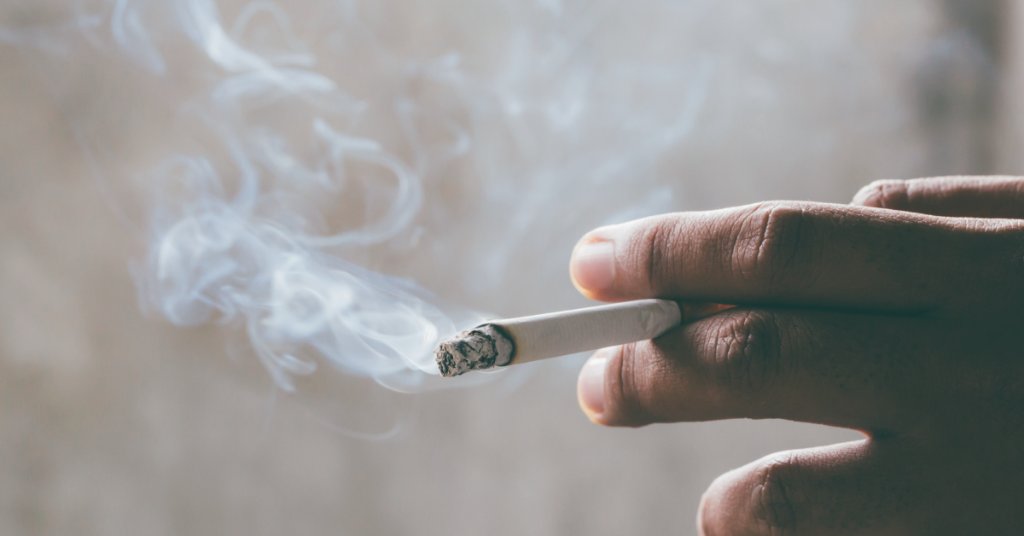 It can help to plan ahead and have plenty of healthy snacks in the kitchen, such as nuts and fruit, and to get rid of the junk food from your house.
It can help to plan ahead and have plenty of healthy snacks in the kitchen, such as nuts and fruit, and to get rid of the junk food from your house.
If you do gain weight in the early days, try not to be too hard on yourself. By quitting smoking you’re doing great things for your health.
Managing smoking withdrawal symptoms
Although withdrawal symptoms can feel challenging, there are ways you can help yourself stay motivated:
- Keep a list of reasons you have decided to quit and keep it handy for those moments when you’re tempted to smoke.
- Make plans and stay busy.
- Engage friends and family to help distract you from your cravings and keep you motivated.
- Remember the four Ds:
- delay acting on the craving for five minutes and it will usually pass
- do some deep breathing
- drink water, or
- do something else.
Routines to help you manage cravings
One of the biggest challenges many people face in the early days of quitting is the regular cravings. Some cravings are your body physically wanting nicotine, but some are also related to your daily routines.
Some cravings are your body physically wanting nicotine, but some are also related to your daily routines.
Changing your routine can help avoid those triggers that tell your brain it’s time for a smoke.
Here are some ideas for activities to do instead of smoking at those times you usually reach for the cigarettes:
- First thing in the morning – have a shower.
- With coffee or tea – change to a different drink, a different cup, or change where you drink it.
- At morning tea – sit in a different place or with different people, read a magazine or take a scroll through your social media.
- At the computer at home – move your desk or redecorate to change the look.
- After a meal – go for a walk.
- After work – exercise or meditate.
- Before dinner – make your dinner time earlier.
- With alcohol – change to a different type of drink or hold your drink in your smoking hand.
- As you plan your next task – breathe deeply.

- As a reward – listen to music or have a piece of fruit.
- When you’re with another smoker – chew gum or bring a water bottle.
- In front of the television – move the furniture around, hold a stress ball, do some easy stretches.
- Before bed – have a warm drink or read a book.
Remember, each time you resist that urge and do something else instead it’s a victory in your quest to quit: you’re helping your brain break that link between the activity and the cigarette.
The more options you have to distract yourself, the better. Here are a few more ideas you can try at any time:
- Sip a glass of water slowly.
- Play with a pet.
- Call a friend.
- Play a game on your phone.
- Ask your partner or a friend for a shoulder massage.
- Try some gardening.
- Put on some hand cream.
- Do a jigsaw puzzle or crossword.
- Peel an orange.
- Think about the reasons you’re quitting and envision a positive future.

Managing stress when you quit smoking
It will take time to settle into new routines and find new ways to deal with stress now that smoking is not an option.
The stress-release you feel when you have a cigarette is only temporary. It doesn’t solve your problems, it only shifts your focus and feeds the smoking stress-cycle.
Research tells us that smokers tend to have higher stress levels than non-smokers. Most people find that their stress levels are lower six months after quitting than they were before they quit.
One of the biggest challenges you’ll face when you quit is finding a new way to take ‘me time’ – at work, when you first get home, after dinner, and other times when you just need some time out.
You might find it helpful to create a special space for yourself to relax. Or you could try revisiting an old hobby or starting a new one.
See How to deal with stress when you quit for ideas on great time-out activities.
Costs of smoking
There is no point dwelling on the amount of money you have already spent on smoking. But you could still save money if you quit, and the sooner you quit, the more money you will save.
But you could still save money if you quit, and the sooner you quit, the more money you will save.
If you smoke a pack of 20 cigarettes a day at $27, you will save around $10,000 a year. Thinking about what else you would like to do with that money can be a great motivator to stick to your quit plan.
Try this cost calculator to see how much you can save by giving up smoking.
Benefits of quitting smoking
Quitting is the best thing you will ever do for your health. It can affect your life in ways you may not even imagine.
Benefits to your health and life from quitting smoking include:
- Your sense of taste and smell may improve, so you may enjoy your food more.
- Exercising to increase your fitness will become easier.
- You will be free from the hassles of smoking, such as smelling of smoke, or always having to make sure you have enough cigarettes.
- Your fertility levels will improve (in both men and women), and if you’re a woman, your chances of having a healthy pregnancy and baby will also increase.

- You will save thousands of dollars a year that you can save or spend on other things.
Your family and friends will also benefit because:
If you start smoking again
If you slip and have a cigarette, don’t use it as an excuse to go back to smoking.
Remove yourself from the situation. Go for a walk, take a deep breath or have a drink of water, and ask yourself if you really want to be a smoker again. Try not to waste your energy on self-blame. Instead, treat your slip-up as a sign to revise your quitting strategy.
If you’ve tried several times to give up smoking and you haven’t succeeded yet, don’t lose hope. It’s common for people to try to quit a number of times before they stop smoking for good.
Next time you quit, spend some time thinking about what has worked for you in the past, and what challenges caused you to relapse. Then make plans for what you will do this time when those temptations come up again.
Help is available to quit
If you could do with a hand, talk to your doctor or pharmacist about options to help you quit, or call Quitline for advice and support. You don’t have to do this alone. And willpower is not the only tool at your disposal – you can buy nicotine patches and quitting medications more cheaply with a script from your doctor.
You don’t have to do this alone. And willpower is not the only tool at your disposal – you can buy nicotine patches and quitting medications more cheaply with a script from your doctor.
You might also like to try QuitCoach. QuitCoach is a program that asks you questions about your smoking and uses your answers to give you personalised advice. Each time you visit the site it asks you relevant questions for your situation and provides updated advice based on your answers.
QuitCoach can be especially useful in helping you decide what quitting aid – such as a nicotine replacement therapy product or medication – could be right for you.
For more information see Quitting tips and Quitting methods.
Where to get help
Smoking and mental health | Mental Health Foundation
We all know the physical health risks of smoking tobacco, but did you know smoking also affects people’s mental health?
*Last updated 9 March 2021
If you’re a smoker, there is now a lot of support available to help you quit.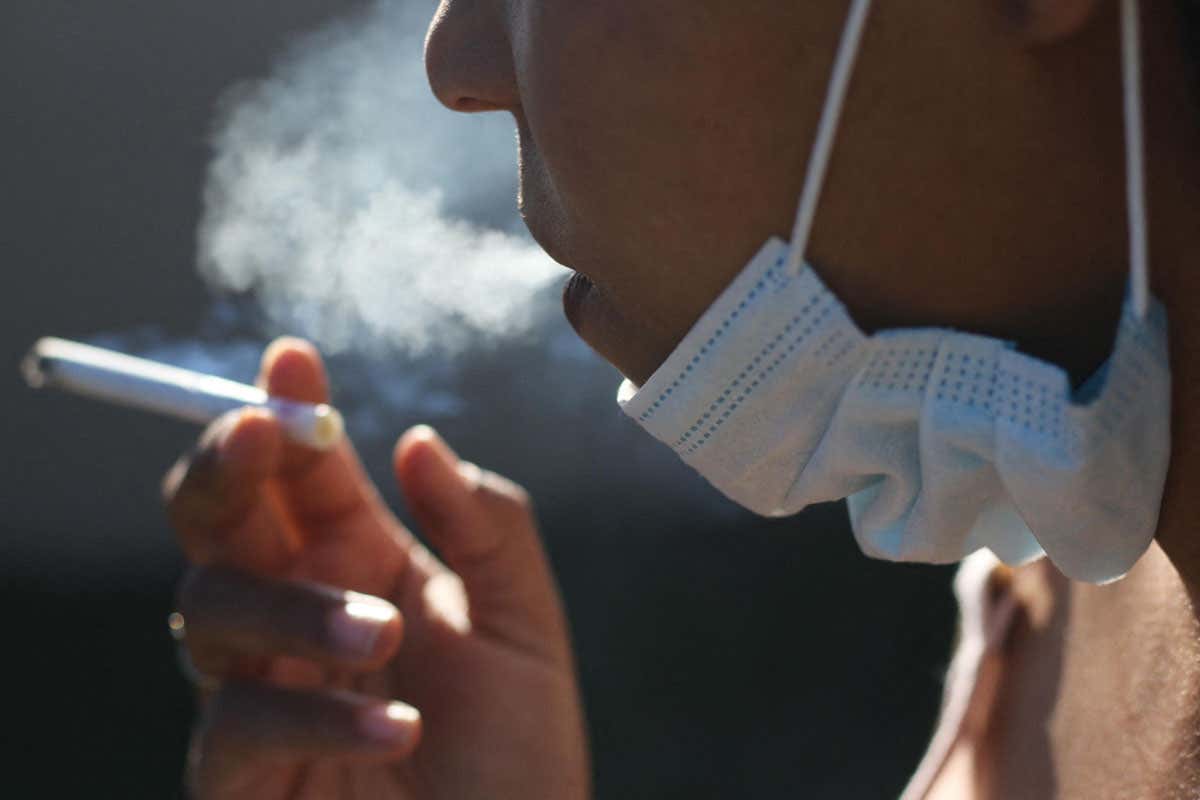 It’s never too late to give up, and you may find that quitting reduces your levels of stress, anxiety and depression.
It’s never too late to give up, and you may find that quitting reduces your levels of stress, anxiety and depression.
Why is smoking so addictive?
When a person smokes, nicotine reaches the brain within about ten seconds. At first, nicotine improves mood and concentration, decreases anger and stress, relaxes muscles and reduces appetite.
Regular doses of nicotine lead to changes in the brain, which then lead to nicotine withdrawal symptoms when the supply of nicotine decreases. Smoking temporarily reduces these withdrawal symptoms and can therefore reinforce the habit. This cycle is how most smokers become nicotine dependent.
Smoking and stress
Some people smoke as ‘self-medication’ to ease feelings of stress. However, research has shown that smoking actually increases anxiety and tension. Nicotine creates an immediate sense of relaxation, so people smoke in the belief it reduces stress and anxiety. This feeling is temporary and soon gives way to withdrawal symptoms and increased cravings. Smoking reduces the withdrawal symptoms, but doesn’t reduce anxiety or deal with the reasons someone may feel that way.
Smoking reduces the withdrawal symptoms, but doesn’t reduce anxiety or deal with the reasons someone may feel that way.
Smoking and depression
Adults with depression are twice as likely to smoke as adults without depression. Most people start to smoke before showing signs of depression, so it’s unclear whether smoking leads to depression or depression encourages people to start smoking. It’s most likely that there is a complex relationship between the two.
Nicotine stimulates the release of the chemical dopamine in the brain. Dopamine is involved in triggering positive feelings. It is often found to be low in people with depression, who may then use cigarettes as a way of temporarily increasing their dopamine supply. However, smoking encourages the brain to switch off its own mechanism for making dopamine so in the long term the supply decreases, which in turn prompts people to smoke more.
People with depression can have particular difficulty when they try to stop smoking and have more severe withdrawal symptoms. Remember there’s lots of support available if you decide to quit, however – you don’t have to go through it alone.
Remember there’s lots of support available if you decide to quit, however – you don’t have to go through it alone.
Smoking and schizophrenia
People with schizophrenia are three times more likely to smoke than other people and tend to smoke more heavily. It’s likely this is because people with schizophrenia use smoking to control or manage some of the symptoms associated with their illness and reduce some of the side effects of their medication.
A recent study has shown smoking may increase the risk of developing schizophrenia. However, further research is needed to fully understand how the two are linked.
Ways to help you quit
Stopping smoking suddenly through willpower alone is the least effective way to quit. If you plan ahead, have support and choose the right time to try, you’re more likely to be successful. If you’re feeling unstable, experiencing a crisis or undergoing significant changes in your life, you’re less likely to quit.
If you take antidepressants or antipsychotic medicines, talk to your GP or psychiatrist before you stop smoking. The dosage you take may need to be monitored and the amount you need to take could be reduced. This is because smoking can reduce the levels of some medications in the blood, so you may need a lower dose when you quit.
The dosage you take may need to be monitored and the amount you need to take could be reduced. This is because smoking can reduce the levels of some medications in the blood, so you may need a lower dose when you quit.
Prepare for change
Think about your relationship with smoking. Write down what you will gain by not smoking, such as better physical health, fresher breath, improved concentration and more money to spend on other things.
Get support from family and friends
Stopping smoking can be easier with the support of family and friends. If you live with people who smoke, or have friends who smoke, suggest to them that you give up together. If other household members smoke, encourage them not to smoke around you or leave their cigarettes, ashtrays or lighters where you will see them.
Find other ways to cope with stress
If you use smoking to cope with stress, you’ll need to find other ways to deal with it. Some things people find helpful are meditation and breathing exercises, regular exercise, cutting down on alcohol, eating a well-balanced diet, acupuncture and hypnosis. Counselling or simply talking to a supportive friend, family member or religious or spiritual leader can also help.
Counselling or simply talking to a supportive friend, family member or religious or spiritual leader can also help.
Find a local stop smoking service
You’re three times as likely to stop smoking successfully if you use a stop smoking service. They offer free one-to-one or group support along with stop smoking medicines. You usually go for a few weeks before you quit, then once a week for four weeks after your last cigarette.
Talk to your GP
Many people don’t realise their GP can help them stop smoking. They may enrol you in a stop smoking clinic, or prescribe nicotine replacement therapy or stop smoking medicine.
Nicotine replacement therapy and medication
Nicotine replacement therapy (NRT), anti-depressants and other medication have all been shown to help smokers without mental health problems to stop smoking and they may also be helpful for people with depression or schizophrenia. NRT appears to be more effective when combined with a talking therapy.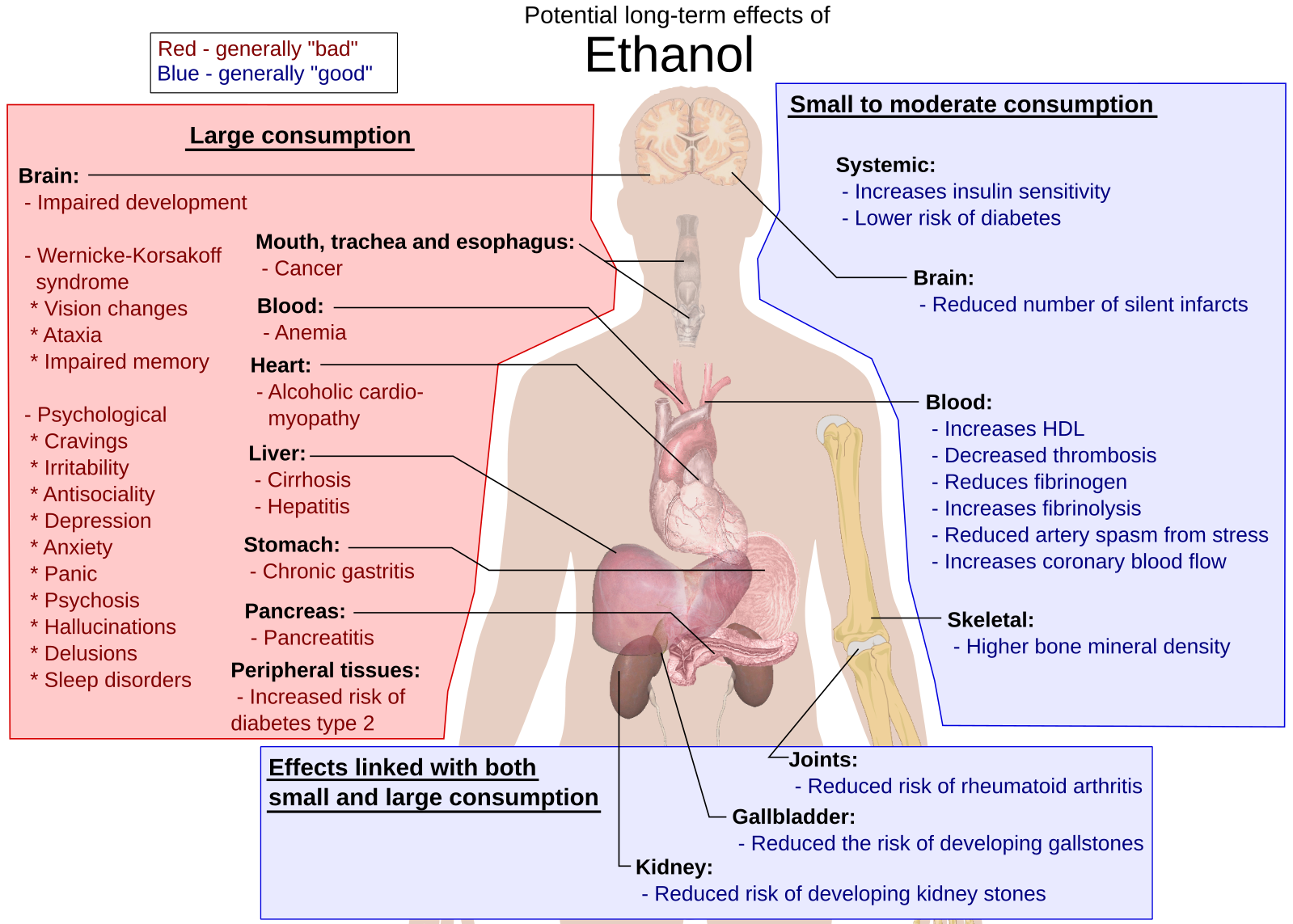
You could also consider e-cigarettes. They’re much safer than cigarettes and can help people stop smoking.
Talk to your doctor, a pharmacist or a health visitor about which treatments might be suitable for you.
Talking therapies
Individual, group or telephone counselling can help people to stop smoking. Talking therapies can help people change their behaviour by thinking and acting more positively. Many counselling programmes use the techniques of cognitive behavioural therapy (CBT) and social skills development. Research has shown that CBT may be particularly effective in smokers with or without mental health problems.
Avoid triggers linked to smoking
Removing all tobacco products from your home can help lessen some of the cravings of nicotine withdrawal.
Learn to recognise your smoking triggers. Identify when you crave cigarettes, such as at a party or after a meal. Try to avoid those situations where possible, or plan ways to resist triggers you can’t avoid.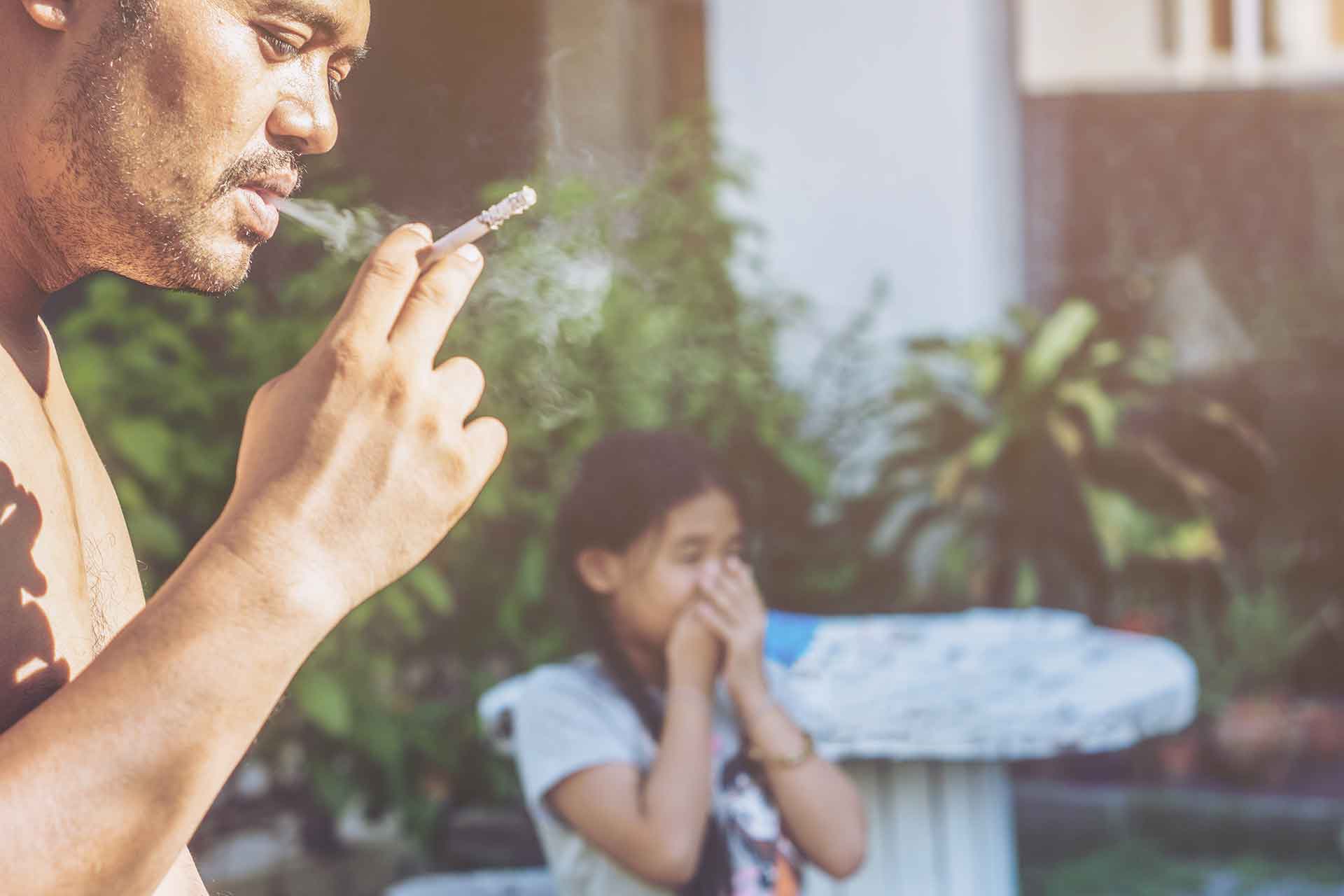 Most cravings only last a few minutes. If you can ride them out, you’ll be closer to quitting for good.
Most cravings only last a few minutes. If you can ride them out, you’ll be closer to quitting for good.
Be prepared for withdrawal symptoms
You may experience headaches, nausea, irritability, anxiety, craving cigarettes, feeling miserable, difficulty in concentrating, increased appetite and drowsiness. Drinking more fresh fruit juice or water, eating more high fibre foods and reducing caffeine and refined sugar in your diet can all help you cope with withdrawal symptoms.
Don’t give up if you relapse
Many people who quit smoking will relapse at some point. Don’t be put off trying again. Use it as an opportunity to reflect on what went wrong, learn about yourself and figure out what will help you be more successful in future.
Further help and supp0rt
In England, call the National Smokefree Helpline on 0300 123 1044 or visit the NHS website . If English isn’t your first language, you can call the helpline and ask to speak to an interpreter for the language you need.
What are the health risks of smoking?
Smoking is one of the biggest causes of death and illness in the UK.
Every year around 78,000 people in the UK die from smoking, with many more living with debilitating smoking-related illnesses.
Smoking increases your risk of developing more than 50 serious health conditions.
Some may be fatal, and others can cause irreversible long-term damage to your health.
You can become ill:
- if you smoke yourself
- if people around you smoke (passive smoking)
Smoking health risks
Smoking causes around 7 out of every 10 cases of lung cancer (70%).
It also causes cancer in many other parts of the body, including the:
- mouth
- throat
- voice box (larynx)
- oesophagus (the tube between your mouth and stomach)
- bladder
- bowel
- cervix
- kidney
- liver
- stomach
- pancreas
Smoking damages your heart and your blood circulation, increasing your risk of developing conditions such as:
Smoking also damages your lungs, leading to conditions such as:
Smoking can also worsen or prolong the symptoms of respiratory conditions such as asthma, or respiratory tract infections such as the common cold.
In men, smoking can cause impotence because it limits the blood supply to the penis.
It can also reduce the fertility of both men and women.
Health risks of passive smoking
Secondhand smoke comes from the tip of a lit cigarette and the smoke that the smoker breathes out.
Breathing in secondhand smoke, also known as passive smoking, increases your risk of getting the same health conditions as smokers.
For example, if you have never smoked but you have a spouse who smokes, your risk of developing lung cancer increases by about a quarter.
Babies and children are particularly vulnerable to the effects of secondhand smoke.
A child who’s exposed to passive smoke is at increased risk of developing chest infections, meningitis, a persistent cough and, if they have asthma, their symptoms will get worse.
They’re also at increased risk of cot death and an ear infection called glue ear.
Read more about passive smoking.
Health risks of smoking during pregnancy
If you smoke when you’re pregnant, you put your unborn baby’s health at risk, as well as your own.
Smoking during pregnancy increases the risk of complications such as:
Read more about stopping smoking in pregnancy.
Getting help
Your GP can give you information and advice on quitting smoking.
You can also call the NHS Smokefree helpline on 0300 123 1044.
Read the answers to more questions about stopping smoking.
Further information
Page last reviewed: 9 October 2018
Next review due: 9 October 2021
Health Risks of Smoking Tobacco
Tobacco use remains the leading preventable cause of death in the US,
accounting for about 1 in 5 deaths each year.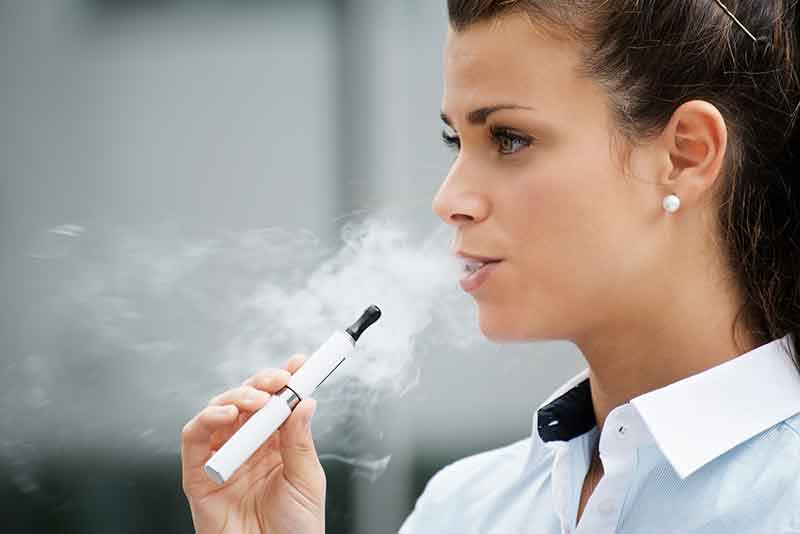
On average, people who smoke die about 10 years earlier than people who have never smoked.
Most people know smoking can cause cancer. But it can also cause a number of other diseases and can damage nearly every organ in the body, including the lungs, heart, blood vessels, reproductive organs, mouth, skin, eyes, and bones.
How smoking tobacco affects your cancer risk
Smoking causes about 20% of all cancers and about 30% of all cancer deaths in the United States.
About 80% of lung cancers, as well as about 80% of all lung cancer deaths, are due to smoking.
Lung cancer is the leading cause of cancer death in both men and women.
Smoking also increases the risk for cancers of the:
It also raises the risk of acute myeloid leukemia.
Cigarettes, cigars, and pipes can all cause cancer. There is no safe form of tobacco smoke.
How smoking tobacco damages your lungs
Smoking damages the airways and small air sacs in your lungs.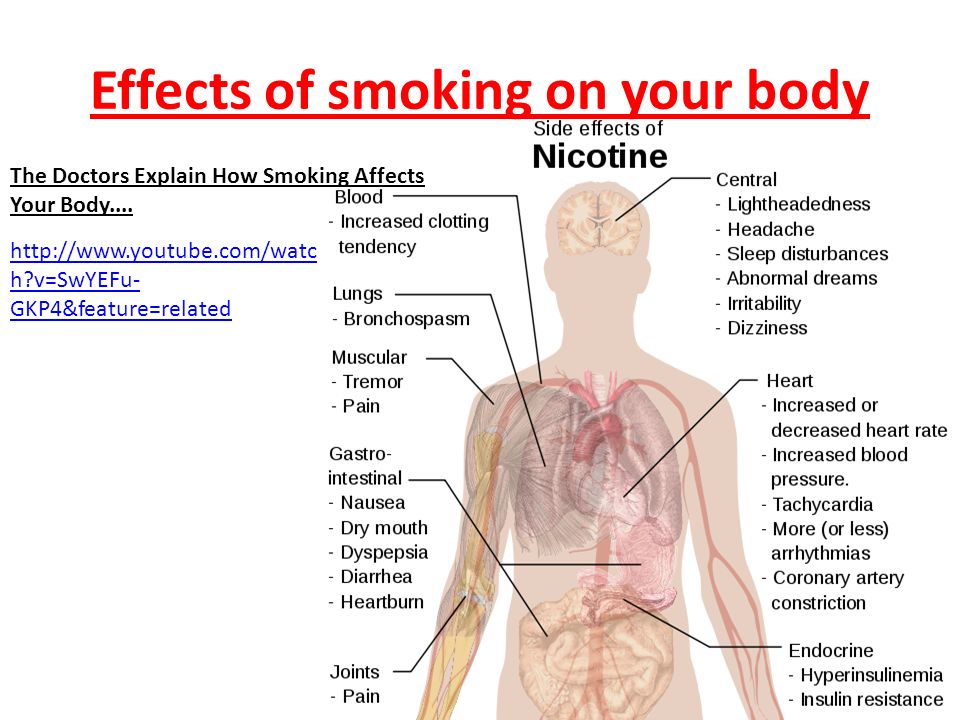 This damage starts soon after someone starts smoking, and lung function continues to worsen as long as the person smokes. Still, it may take years for the problem to become noticeable enough for lung disease to be diagnosed.
This damage starts soon after someone starts smoking, and lung function continues to worsen as long as the person smokes. Still, it may take years for the problem to become noticeable enough for lung disease to be diagnosed.
Smoke damage in the lungs can lead to serious long-term lung diseases such as chronic obstructive pulmonary disease (COPD). Smoking can also increase the risk of lung infections such as pneumonia and tuberculosis, and it can worsen some existing lung diseases, such as asthma.
COPD
COPD, which is one of the leading causes of death in the United States, includes both chronic bronchitis and emphysema (discussed below). Most people with COPD have both of these conditions, but the severity of each of them varies from person to person.
In COPD, damage to the small airways in the lungs makes it hard for the lungs to get oxygen to the rest of the body.
Smoking is by far the most common cause of COPD. The risk goes up the more you smoke and the longer you smoke.
The risk goes up the more you smoke and the longer you smoke.
Some of the early signs and symptoms of COPD can include noises in the chest (such as wheezing, rattling, or whistling), shortness of breath when active, and coughing up mucus (phlegm). Over time, COPD can make it hard to breathe at rest as well, sometimes even when a person is getting oxygen through a mask or nasal tube.
COPD tends to get worse over time, especially if a person continues to smoke. There is no cure for COPD, although some medicines might help with symptoms.
Chronic bronchitis
Chronic bronchitis is a common problem in people who smoke for a long time. In this disease, the airways make too much mucus, forcing the person to try to cough it out. The airways become inflamed (swollen), and the cough becomes chronic (long-lasting). The symptoms can get better at times, but the cough keeps coming back. Over time, the airways can get blocked by scar tissue and mucus, which can lead to bad lung infections (pneumonia).
There’s no cure for chronic bronchitis, but quitting smoking can help keep symptoms under control and help keep the damage from getting worse.
Emphysema
In emphysema, the walls between the tiny air sacs in the lungs break down, which creates larger but fewer sacs. This lowers the amount of oxygen reaching the blood. Over time, these sacs can break down to the point where a person with emphysema might struggle to get enough air, even when at rest.
People with emphysema are at risk for many other problems linked to weak lung function, including pneumonia. In later stages of the disease, patients often need an oxygen mask or tube to help them breathe.
Emphysema cannot be cured, but it can be treated and slowed down if the person stops smoking.
Why do people who smoke have “smoker’s cough?”
Tobacco smoke has many chemicals and particles that can irritate the upper airways and the lungs. When a person inhales these substances, the body tries to get rid of them by making mucus and causing a cough.
The early morning cough common among people who smoke happens for many reasons. Normally, tiny hair-like structures (called cilia) in the airways help sweep harmful material out of the lungs. But tobacco smoke slows this sweeping action, so some of the mucus and particles in the smoke stay in the lungs and airways. While the person sleeps (and doesn’t smoke), some cilia recover and start working again. After waking up, the person coughs because the lungs are trying to clear away the irritants and mucus that built up from the day before.
So-called “smoker’s cough” can be an early sign of COPD.
How smoking tobacco affects your heart and blood vessels
Smoking tobacco damages your heart and blood vessels (cardiovascular system), increasing your risk of heart disease and stroke.
Smoking is a major cause of coronary heart disease (CHD), in which the arteries of the heart can’t supply the heart muscle with enough oxygen-rich blood. CHD is the main cause of heart attacks, and it’s the leading cause of death in the United States.
CHD is the main cause of heart attacks, and it’s the leading cause of death in the United States.
Smoking causes high blood pressure, lowers your ability to exercise, and makes your blood more likely to clot. It also lowers HDL (good) cholesterol levels in the blood. All of these are risk factors for heart attacks and strokes.
Smoking is a major risk factor for peripheral arterial disease (PAD). In PAD, plaque builds up in the arteries that carry blood to the head, organs, and limbs. This increases your risk of heart disease, heart attack, and stroke.
Smoking increases the risk of having an aortic aneurysm. This is a balloon-like bulge in the aorta, the main artery carrying blood from the heart to other organs. It is caused by a weakening of the wall of the aorta. Aortic aneurysms can grow larger over time, and they can be life threatening if they rupture (break open).
Smoking can cause or worsen poor blood flow to the arms and legs, which is called peripheral vascular disease or (PVD). This can lead to pain in the legs when walking, and may lead to open sores that don’t heal.
This can lead to pain in the legs when walking, and may lead to open sores that don’t heal.
Because smoking affects blood flow, it can lower the body’s ability to heal from cuts. This is why many doctors won’t do certain operations on patients unless they stop smoking.
How smoking tobacco can affect your sex life and reproductive system
Women
Tobacco use can damage a woman’s reproductive health. For example, women who smoke are more likely to have trouble getting pregnant.
Smoking while pregnant can also lead to health problems that can affect both mother and baby. Women who smoke while pregnant have a higher risk of:
- An ectopic pregnancy (where the embryo implants outside the uterus), which can threaten the mother’s life
- Problems with the placenta, which is the organ that connects the mother to fetus. The placenta might be in the wrong spot (placenta previa), or it might separate from the uterus too early (placental abruption).
 These problems might lead to serious bleeding, early delivery (premature birth), or other problems with the delivery, some of which might require an emergency Caesarean section (C-section).
These problems might lead to serious bleeding, early delivery (premature birth), or other problems with the delivery, some of which might require an emergency Caesarean section (C-section). - Premature births and low birth-weight babies
- Miscarriages and stillbirths
- Having a child with a cleft lip, cleft palate, and possibly other birth defects
Babies of mothers who smoke during and after pregnancy are also more likely to die from sudden infant death syndrome (SIDS).
Men
Smoking can damage blood vessels anywhere in the body. Blood flow in the penis is a key part of male erections. Men who smoke have a higher risk of erectile dysfunction. This risk increases the more they smoke and the longer they smoke.
Smoking can also affect sperm, which can reduce fertility and increase the risk for miscarriages and birth defects.
Other ways smoking tobacco affects your health
Smoking can affect a person’s health in many other ways as well, harming nearly every organ in the body. Here are a few examples of other ways smoking tobacco can affect your health:
- Increased risk of gum disease and tooth loss
- Lowered immune system function
- Increased risk of type 2 diabetes
- Decreased sense of smell and taste
- Premature aging of the skin
- Bad breath and stained teeth
- Lower bone density (thinner bones), which means a higher risk for broken bones, including hip fracture
- Higher risk of rheumatoid arthritis
- Increased risk for cataracts (clouding of the lenses of the eyes)
- Increased risk for age-related macular degeneration, which can lead to blindness
- Wounds taking longer to heal
Many of the health problems linked to smoking can lower a person’s quality of life.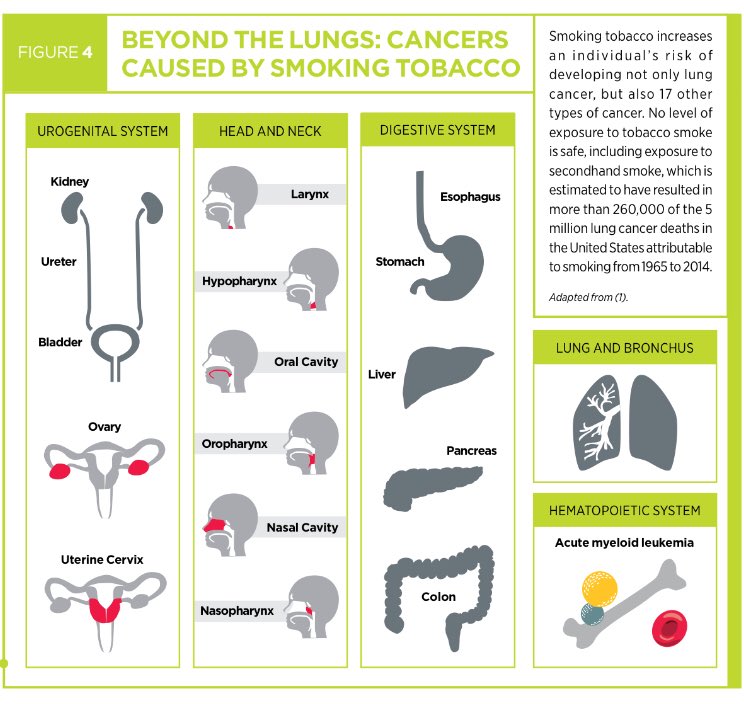 Smoking-related illness can make it harder for a person to breathe, get around, work, or play. Quitting smoking, especially at younger ages, can reduce smoking-related disability.
Smoking-related illness can make it harder for a person to breathe, get around, work, or play. Quitting smoking, especially at younger ages, can reduce smoking-related disability.
How smoking tobacco can affect children and teens
Cigarette smoking and the use of tobacco products can cause health problems in children and teens. Over time, these can include the serious health problems discussed above, which might start at even younger ages.
One of the most serious problems is nicotine addiction, which often leads to long-term tobacco use as kids get older. There is also some evidence that nicotine harms the brain development of teenagers.
It is important to know that most e-cigarettes and similar products also contain nicotine.
Children and teens who smoke regularly tend to have more health problems than kids who don’t, such as:
- Coughing spells
- Shortness of breath, even when not exercising
- Wheezing or gasping
- More frequent headaches
- Increased phlegm (mucus)
- Respiratory illnesses that are worse and happen more often
- Worse cold and flu symptoms
- Reduced physical fitness
- Poor lung growth and function, which increases the risk of COPD later in life
Tobacco use is linked to other harmful behaviors in teens
Research has shown that teen tobacco users are more likely to use alcohol and illegal drugs than are non-users. Teens who smoke are also more likely to get into fights, carry weapons, attempt suicide, suffer from mental health problems such as depression, and engage in high-risk sexual behaviors. This doesn’t necessarily mean that tobacco use caused these behaviors, but they’re more common in teens who use tobacco.
Teens who smoke are also more likely to get into fights, carry weapons, attempt suicide, suffer from mental health problems such as depression, and engage in high-risk sexual behaviors. This doesn’t necessarily mean that tobacco use caused these behaviors, but they’re more common in teens who use tobacco.
In addition, using e-cigarettes (also known as vaping) might play a part in a kid or teenager wanting to experiment with other tobacco products.
To learn more about e-cigarettes, see What Do We Know About E-cigarettes?
Smoking: Coping with Withdrawal – NYC Health
New Resource: Be Free with Nicotine Replacement Therapy (NRT) Toolkit
More places in New York City are becoming smoke-free. Even if you are not ready to quit, consider nicotine replacement therapy (NRT) to help you manage nicotine withdrawal symptoms or cravings when in situations where you can’t smoke. A kit of new resources has been developed to support people and providers with using NRT.
Resources for Individuals
Resources for Health Care, Social Service and Housing Providers
When you are trying to quit smoking or vaping, it is important to learn healthy strategies to help you manage stress, triggers and withdrawal symptoms.
Withdrawal Symptoms
Many people have withdrawal symptoms when they stop smoking or vaping, whether they are trying to quit or just stay smoke-free in indoor or public spaces where smoking is not allowed. Depending on how much you smoke or vape, you may experience one or more of the following symptoms:
- Increased appetite/weight gain
- Depressed mood
- Insomnia/sleep problems
- Irritability
- Anxiety
- Difficulty concentrating
- Restlessness
Tobacco-treatment medications (PDF), including nicotine replacement therapy (the patch, gum, lozenge, inhaler and nasal spray), bupropion SR (Zyban® or Wellbutrin®) or varenicline (Chantix®), can help you prevent withdrawal symptoms. These medications can help you stay tobacco-free when you need or want to be, whether or not you want to quit. Most health insurance plans (PDF), including Medicaid, cover these medications to help you stay tobacco-free.
These medications can help you stay tobacco-free when you need or want to be, whether or not you want to quit. Most health insurance plans (PDF), including Medicaid, cover these medications to help you stay tobacco-free.
To better understand your relationship with tobacco, take this quiz.
Tips for Coping with Nicotine Withdrawal
Ready to Quit? Make It Easier
- Find your reasons. Make a list of reasons for quitting and read it often.
- Pick a quit date. Choose a day that works for you and gives you time to prepare. Throw out all your cigarettes beforehand, and get rid of ashtrays and lighters.
- Get support and encouragement. Tell your family, friends and co-workers that you are quitting and ask for their support.
- Identify and avoid triggers. Alcohol, coffee, stress and being around others who smoke can all trigger cravings. Notice what makes you crave smoking and avoid those situations or change your routine.

- Reduce caffeine intake. Cutting down your caffeine intake by at least half when you quit smoking can help you avoid withdrawal symptoms, such as difficulty concentrating, anxiety and restlessness.
- Keep trying. It often takes multiple tries to quit smoking, so do not be discouraged to try again. You have not failed — you learned more about your triggers. Throw out your cigarettes and start again.
More Information
Smoking and Asthma (for Teens)
Does Smoking Make Asthma Worse?
Yes. If you have asthma, smoking is especially risky because of the damage it does to the lungs.
Smoke irritates the airways, making them swollen, narrow, and filled with sticky mucus — the same things that happen during an asthma flare-up. That’s why smoking can cause asthma flare-ups (or “attacks”) to happen more often. They also might be more severe and harder to control, even with medicine.
Why Should I Quit Smoking?
You may have started smoking because friends do or because you grew up in a house where other people smoked.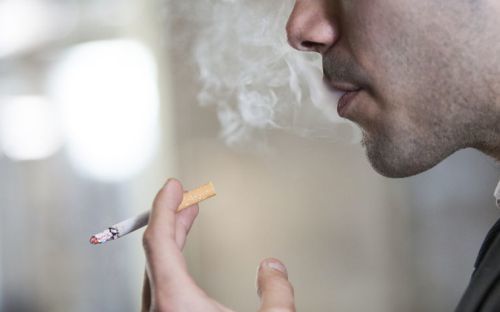 No matter why you started, if you’re thinking about quitting, it would probably help your asthma.
No matter why you started, if you’re thinking about quitting, it would probably help your asthma.
Here are some other reasons to quit:
- Smoking can undo the effect of any long-term control medicine you’re taking.
- Smoking can force you to use your quick-relief medicine more often.
- Smoking can disturb your sleep by making you cough more at night.
- Smoking can affect how well you do in sports or other physical activities.
- Worst of all, smoking can send you to the ER with a severe asthma flare-up.
If you decide to quit, you don’t have to go it alone. Get support from other people — like friends, family, or other smokers who are trying to quit. Ask your doctor about medicines or things you can do to crave cigarettes less. Your doctor wants to help you quit!
Can Secondhand Smoke Affect My Asthma?
Even if you don’t smoke, you may still run into smoky situations at parties, events, or even at home. Secondhand smoke is a known asthma trigger. You’ll want to avoid it as much as possible if you have asthma.
You’ll want to avoid it as much as possible if you have asthma.
If you hang out with smokers or have a family member who smokes in the house, you’re likely to have more frequent and severe asthma symptoms. That might mean more medicine and more trips to the doctor’s office or ER.
There’s not much you can do about other people’s behavior. But let your friends and family know that what they’re doing is making your asthma worse. Ask them not to smoke in your house or car.
Is Vaping OK for People With Asthma?
Some people with asthma might think that e-cigarettes (“vaping”) are a safe alternative to smoking. E-cigarettes don’t fill the lungs with smoke, but do put nicotine in your system. Besides being an addictive drug, nicotine is also toxic in high doses, and raises blood pressure and heart rate.
Experts also agree that the vapors from e-cigarettes are harmful not only to those to vape, but to those around them.
Cigarettes and Other Tobacco Products DrugFacts
What is tobacco?
Tobacco leaves drying in a row.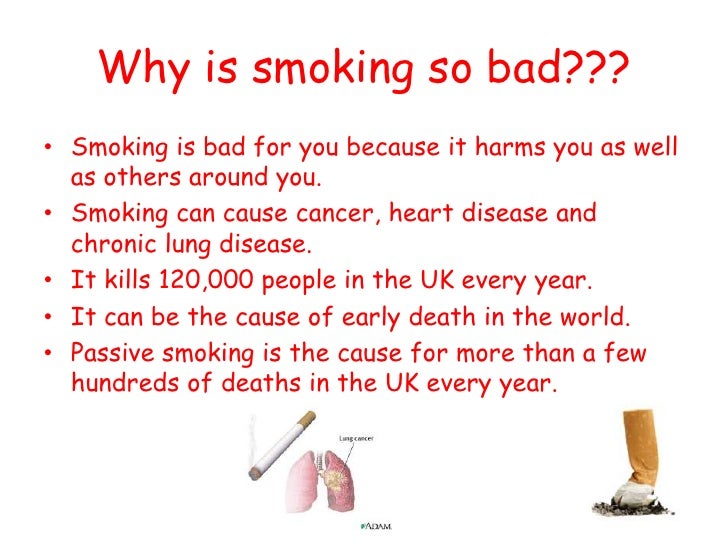
Tobacco is a plant grown for its leaves, which are dried and fermented before being put in tobacco products. Tobacco contains nicotine, an ingredient that can lead to addiction, which is why so many people who use tobacco find it difficult to quit. There are also many other potentially harmful chemicals found in tobacco or created by burning it.
How do people use tobacco?
People can smoke, chew, or sniff tobacco. Smoked tobacco products include cigarettes, cigars, bidis, and kreteks. Some people also smoke loose tobacco in a pipe or hookah (water pipe). Chewed tobacco products include chewing tobacco, snuff, dip, and snus; snuff can also be sniffed.
How does tobacco affect the brain?
The nicotine in any tobacco product readily absorbs into the blood when a person uses it. Upon entering the blood, nicotine immediately stimulates the adrenal glands to release the hormone epinephrine (adrenaline). Epinephrine stimulates the central nervous system and increases blood pressure, breathing, and heart rate. As with drugs such as cocaine and heroin, nicotine activates the brain’s reward circuits and also increases levels of the chemical messenger dopamine, which reinforces rewarding behaviors. Studies suggest that other chemicals in tobacco smoke, such as acetaldehyde, may enhance nicotine’s effects on the brain.
As with drugs such as cocaine and heroin, nicotine activates the brain’s reward circuits and also increases levels of the chemical messenger dopamine, which reinforces rewarding behaviors. Studies suggest that other chemicals in tobacco smoke, such as acetaldehyde, may enhance nicotine’s effects on the brain.
What are other health effects of tobacco use?
Although nicotine is addictive, most of the severe health effects of tobacco use comes from other chemicals. Tobacco smoking can lead to lung cancer, chronic bronchitis, and emphysema. It increases the risk of heart disease, which can lead to stroke or heart attack. Smoking has also been linked to other cancers, leukemia, cataracts, Type 2 Diabetes, and pneumonia. All of these risks apply to use of any smoked product, including hookah tobacco. Smokeless tobacco increases the risk of cancer, especially mouth cancers.
Electronic Cigarettes
Electronic cigarettes, also known as e-cigarettes or e-vaporizers, are battery-operated devices that deliver nicotine with flavorings and other chemicals to the lungs in vapor instead of smoke. E-cigarette companies often advertise them as safer than traditional cigarettes because they don’t burn tobacco. But researchers actually know little about the health risks of using these devices. Read more about e-cigarettes in our Electronic Cigarettes (e-Cigarettes) DrugFacts.
E-cigarette companies often advertise them as safer than traditional cigarettes because they don’t burn tobacco. But researchers actually know little about the health risks of using these devices. Read more about e-cigarettes in our Electronic Cigarettes (e-Cigarettes) DrugFacts.
Pregnant women who smoke cigarettes run an increased risk of miscarriage, stillborn or premature infants, or infants with low birth weight. Smoking while pregnant may also be associated with learning and behavioral problems in exposed children.
People who stand or sit near others who smoke are exposed to secondhand smoke, either coming from the burning end of the tobacco product or exhaled by the person who is smoking. Secondhand smoke exposure can also lead to lung cancer and heart disease. It can cause health problems in both adults and children, such as coughing, phlegm, reduced lung function, pneumonia, and bronchitis. Children exposed to secondhand smoke are at an increased risk of ear infections, severe asthma, lung infections, and death from sudden infant death syndrome.
How does tobacco use lead to addiction?
Surgeon General’s Report on Smoking Cessation
The Surgeon General’s Report on Smoking Cessation, released in January 2020, offers evidence that smoking cessation is beneficial at any age, improves health status and enhances quality of life. It also reduces the risk of premature death and can add as much as a decade to life expectancy.
For many who use tobacco, brain changes brought on by continued nicotine exposure result in addiction. When a person tries to quit, he or she may have withdrawal symptoms, including:
- irritability
- problems paying attention
- trouble sleeping
- increased appetite
- powerful cravings for tobacco
How can people get treatment for nicotine addiction?
Both behavioral treatments and medications can help people quit smoking, but the combination of medication with counseling is more effective than either alone.
The U. S. Department of Health and Human Services has established a national toll-free quitline, 1-800-QUIT-NOW, to serve as an access point for anyone seeking information and help in quitting smoking.
S. Department of Health and Human Services has established a national toll-free quitline, 1-800-QUIT-NOW, to serve as an access point for anyone seeking information and help in quitting smoking.
Government Regulation of Tobacco Products
On May 5, 2016, the FDA announced that nationwide tobacco regulations now extend to all tobacco products, including
- e-cigarettes and their liquid solutions
- cigars
- hookah tobacco
- pipe tobacco
This ruling includes restricting sale of these products to minors. For more information, see the FDA’s webpage, The Facts on the FDA’s New Tobacco Rule.
In December 2019, the federal government raised the legal minimum age of sale of tobacco products from 18 to 21 years, and in January 2020, the FDA issued a policy on the sale of flavored vaping cartridges.
Behavioral Treatments
Behavioral treatments use a variety of methods to help people quit smoking, ranging from self-help materials to counseling. These treatments teach people to recognize high-risk situations and develop strategies to deal with them. For example, people who hang out with others who smoke are more likely to smoke and less likely to quit.
These treatments teach people to recognize high-risk situations and develop strategies to deal with them. For example, people who hang out with others who smoke are more likely to smoke and less likely to quit.
Nicotine Replacement Therapies
Nicotine replacement therapies (NRTs) were the first medications the U.S. Food and Drug Administration (FDA) approved for use in smoking cessation therapy.
Current FDA-approved NRT products include chewing gum, transdermal patch, nasal sprays, inhalers, and lozenges. NRTs deliver a controlled dose of nicotine to relieve withdrawal symptoms while the person tries to quit.
Other Medications
Bupropion (Zyban®) and varenicline (Chantix®) are two FDA-approved non-nicotine medications that have helped people quit smoking. They target nicotine receptors in the brain, easing withdrawal symptoms and blocking the effects of nicotine if people start smoking again.
Can a person overdose on nicotine?
Nicotine is poisonous and, though uncommon, overdose is possible. An overdose occurs when the person uses too much of a drug and has a toxic reaction that results in serious, harmful symptoms or death. Nicotine poisoning usually occurs in young children who accidentally chew on nicotine gum or patches used to quit smoking or swallow e-cigarette liquid. Symptoms include difficulty breathing, vomiting, fainting, headache, weakness, and increased or decreased heart rate. Anyone concerned that a child or adult might be experiencing a nicotine overdose should seek immediate medical help.
An overdose occurs when the person uses too much of a drug and has a toxic reaction that results in serious, harmful symptoms or death. Nicotine poisoning usually occurs in young children who accidentally chew on nicotine gum or patches used to quit smoking or swallow e-cigarette liquid. Symptoms include difficulty breathing, vomiting, fainting, headache, weakness, and increased or decreased heart rate. Anyone concerned that a child or adult might be experiencing a nicotine overdose should seek immediate medical help.
Reports of Deaths Related to Vaping
The Food and Drug Administration has alerted the public to hundreds of reports of serious lung illnesses associated with vaping, including several deaths. They are working with the Centers for Disease Control and Prevention (CDC) to investigate the cause of these illnesses. Many of the suspect products tested by the states or federal health officials have been identified as vaping products containing THC, the main psychotropic ingredient in marijuana. Some of the patients reported a mixture of THC and nicotine; and some reported vaping nicotine alone. No one substance has been identified in all of the samples tested, and it is unclear if the illnesses are related to one single compound. Until more details are known, FDA officials have warned people not to use any vaping products bought on the street, and they warn against modifying any products purchased in stores. They are also asking people and health professionals to report any adverse effects. The CDC has posted an information page for consumers.
Points to Remember
- Tobacco is a plant grown for its leaves, which are dried and fermented before being put in tobacco products. Tobacco contains nicotine, the ingredient that can lead to addiction.
- People can smoke, chew, or sniff tobacco.
- Nicotine acts in the brain by stimulating the adrenal glands to release the hormone epinephrine (adrenaline) and by increasing levels of the chemical messenger dopamine.
- Tobacco smoking can lead to lung cancer, chronic bronchitis, and emphysema. It increases the risk of heart disease, which can lead to stroke or heart attack. Smoking has also been linked to other cancers, leukemia, cataracts, and pneumonia. Smokeless tobacco increases the risk of cancer, especially mouth cancers.
- Secondhand smoke can lead to lung cancer and heart disease as well as other health effects in adults and children.
- For many who use tobacco, brain changes brought on by continued nicotine exposure result in addiction.
- Both behavioral treatments and medication can help people quit smoking, but the combination of medication with counseling is more effective than either alone.
- Nicotine overdose is possible, though it usually occurs in young children who accidentally chew on nicotine gum or patches or swallow e-cigarette liquid.
- Anyone concerned that a child or adult might be experiencing a nicotine overdose should seek immediate medical help.
Learn More
For more information about tobacco products and nicotine, visit:
This publication is available for your use and may be reproduced in its entirety without permission from NIDA. Citation of the source is appreciated, using the following language: Source: National Institute on Drug Abuse; National Institutes of Health; U.S. Department of Health and Human Services.
90,000 Signs of nicotine addiction – how smoking addiction develops
Everyone knows about the negative effects of smoking on the body, but this does not force you to quit the bad habit. Even after learning about lung cancer associated with tobacco smoking, few give up cigarettes. Nicotine addiction does not give this. It is considered one of the forms of household drug addiction that needs to be treated. This requires complex measures, with the help of one desire, only 7% of people get rid of addiction.
General
More than 4 thousand chemicals were found in the composition of tobacco smoke. 40 of them have carcinogenic properties and are able to stimulate the development of cancer. But the main effect on the psyche is nicotine. It is a natural substance, a natural component of tobacco leaves, for which a person smokes.
During smoking, smoke enters the lungs, its components are quickly absorbed into the bloodstream and carried throughout the body. The effect of nicotine on the brain begins 15 seconds after the first puff.This rate is comparable to intravenous drugs.
Transmission of signals between brain cells occurs with the help of neurotransmitters. These are biologically active substances that are produced by neurons and some organs of the endocrine system. Nicotine is structurally similar to the neurotransmitter acetylcholine. Therefore, nerve cells actively capture it with the help of receptors. In response to stimulation by nicotine, neurons increase the release of dopamine, the hormone of happiness and euphoria. At the same time, the concentration of adrenaline, norepinephrine, and cortisol – hormones involved in stress reactions – increases in the blood.
A cascade of biochemical reactions leads to the appearance of signs of smoking. A person feels a surge of cheerfulness, his mood rises or the emotional background is leveled. The smoker feels like his brain is working better. This positive effect is pleasing to the body. But after about 2 hours, half of the nicotine that entered the blood is destroyed, therefore, with the formed addiction, there is a desire to smoke a new cigarette.
But this effect does not appear immediately after smoking.It takes time to develop nicotine addiction. In adolescents and children with an immature nervous system, the process proceeds faster than in an adult who started smoking after 20 years. It is almost impossible to get rid of the addiction acquired at a young age.
Psychological dependence on smoking
The first experience of smoking cigarettes is accompanied by unpleasant sensations and sometimes acute nicotine intoxication. A person has the following symptoms:
- cough;
- dizziness;
- increased salivation;
- nausea;
90,021 headache;
90,021 vomiting.
With regular intake of small doses of nicotine, resistance to its effects is gradually formed. After one cigarette, you no longer experience nausea, vomiting or dizziness.
Psychological addiction to nicotine develops first. It is associated with the ritual of smoking and certain situations when the need for tobacco arises. First it is a company in which the majority of smokers, nervous tension in which cigarettes are used to distract thoughts.Many men start smoking during military service when a long wait or long break needs to be filled. Then tobacco use is associated with a cup of coffee, driving and other situations.
At the stage of psychological dependence there is still no acute need for nicotine, the process itself is important. Narcologists call this stereotypical behavior. Therefore, a person can easily quit smoking and not experience withdrawal if they manage to break the psychological model.
Special conditions are required to start smoking and form addiction.Some researchers believe that the cause of the bad habit is heredity. 50% of children from families where parents smoke also become addicted. In non-smoking families, the bad habit appears in 25% of children. But this feature is more indicative of memorization of adult behavior patterns and greater availability of cigarettes.
The desire to start smoking, and the subsequent addiction, develops under the following conditions:
- desire to seem like an adult, increase your social status and self-esteem;
- establishing interpersonal contacts, smoking for the company;
- reduction of withdrawal symptoms in other types of addiction.
90,021 frequent stress and a feeling of relaxation, which is caused by smoking;
Psychological dependence on smoking is a special type of conditioned reflex. The brain remembers and then learns the conditions under which it receives a dose of nicotine. If a person often finishes lunch with a cigarette, then gradually each time after eating, the desire to smoke will appear.
Physiological dependence on nicotine
After the rapid development of mental attachment, the bad habit gradually turns into the stage of physical dependence. This is a condition in which the body needs the constant presence of nicotine.It forms a strong addiction that is comparable to drug use. At the same time, a person understands the harm of smoking, but is not able to withstand more than a few days. Quitting cigarettes causes symptoms of withdrawal symptoms or withdrawal symptoms.
With physical dependence, resistance to nicotine is formed. This manifests itself as a lack of euphoria and relaxation after smoking. Therefore, a person gradually increases the number of cigarettes smoked per day. The habit is to smoke immediately after waking up, on an empty stomach, after eating.The intervals between smoked cigarettes are shortened to 1-2 hours. If it is not possible to do this, then the following symptoms appear:
- feelings of anxiety and anxiety;
- increased irritability;
- difficulty concentrating attention;
- increased appetite.
90,021 dysphoria;
90,021 an uncontrollable desire to smoke;
90,021 headache;
The symptoms of withdrawal symptoms reach their maximum in 24-48 hours, and then gradually decrease.
When a person develops a physical addiction, nicotine consumption gets out of control. After a few years, the negative effect of tobacco on the entire body is manifested. Smokers understand that morning cough, increased frequency of respiratory diseases, cardiovascular pathologies are formed due to addiction. Against the background of vascular damage by tobacco components, blood clots form, which can cause a stroke or heart attack. Cancer of the lungs, larynx, or lower lip also predominantly occurs in people with long smoking history.
Symptoms and treatment of nicotine addiction
Most people do not consider the urge to smoke to be a mental disorder, but in the International Classification of Diseases, nicotine addiction is included in the section of behavioral and mental disorders. Therefore, the treatment of pathology should be dealt with by a psychiatrist and a narcologist.
When contacting a specialist to get rid of tobacco smoking, the doctor determines the severity of the condition based on certain symptoms. For this, the Fagerstorm questionnaire is used.In it, it is necessary to answer questions about the number of cigarettes smoked per day, smoking after waking up and the general experience of using tobacco. The more a person depends on tobacco, the longer the treatment takes and the higher the risk of breakdown.
To get rid of the signs of addiction, it is recommended to see a doctor. Without special medical care, only 5% of people manage to overcome the bad habit, and with treatment by specialists, remission for 3 years or more is achieved in 25%.
Treatment includes nicotine replacement therapy.To do this, use various types of drugs for bad habits:
- nicotine patch;
- mouth spray;
- lozenges.
90,021 chewing gum;
Withdrawal symptoms from smoking cessation may be accompanied by insomnia, gustatory hallucinations, anxiety and irritability. The doctor selects sedatives depending on the severity of the symptoms. In mild cases, herbal infusions, valerian tablets, motherwort, or other herbal remedies are sufficient.In severe forms, hypnotics, mild tranquilizers are used.
Cognitive psychotherapy is included in the treatment program. It helps to understand the causes of smoking, teaches how to respond to pathological desire and avoid situations in which you want to smoke. In some cases, hypnosis and aversive therapy are used, in which aversion to tobacco is formed and the patient is taught to do without it.
A former smoker can return to a bad habit, while addiction accelerates the pace of development.Therefore, effective treatment requires a psychologically correct attitude, cooperation with a good specialist and the support of loved ones.
90,000 About the dangers of smoking
11 February 2021
About the dangers of smoking
Smoking is one of the most significant threats to human health.
According to the World Health Organization
Tobacco causes nearly 7 million deaths each year, of which more than 6 million are among tobacco users and former users, and over 890,000 among non-smokers exposed to second-hand smoke.Unless urgent action is taken, the number of annual deaths by 2030 could exceed 8 million.
On the effects of smoking on the body
Smoking tobacco leads to addiction.
Smokers quickly develop an addiction to the nicotine contained in tobacco leaves, which leads to a strong need to smoke over and over again.
When a person tries to quit smoking, he or she may have withdrawal symptoms, including:
• irritability
• decreased concentration of attention
• sleep problems
• increased appetite
• powerful cravings for tobacco.
In addition to nicotine, a number of other hazardous chemicals are found in tobacco smoke, such as tar, radioactive polonium, arsenic, lead, bismuth, ammonia, and organic acids. There are practically no cases of acute poisoning with these substances due to the fact that they enter the body slowly, dosed, but these substances lead to a gradual deterioration in health.
When 20 g of tobacco is burned, the average is formed:
0.0012 g of hydrocyanic acid;
About 0.0012 g.hydrogen sulfide;
0.22 g of pyridine bases;
0.18 g of nicotine;
0.64 g of ammonia;
0.92 g of carbon monoxide;
Not less than 1 g of concentrate from liquid and solid products of combustion and dry distillation of tobacco
Many smokers believe that smoking filter cigarettes is safe, but this is not the case. If absorbers and filters provided complete protection against harmful substances, then they would also absorb nicotine itself, in which case the effect of smoking would not be felt.Smokers of light cigarettes also find that smoking light cigarettes has minimal impact on the body.
The harm caused by smoking any cigarette is the same for all smokers.
In addition to the smoker himself, those who are around – the so-called passive smokers – also suffer.
Long-term smoking leads to diseases of various organs and systems.
How much health damage does tobacco use cause in general?
Smoking increases the risk of dying from cancer and other diseases in cancer patients and healthy people.
Smoking can cause cancer in any organ:
• bladder
• blood (acute myeloid leukemia)
• cervix
• intestine
• esophagus
• kidneys and ureters
• larynx
• liver
• oral cavity (throat, tongue, soft palate and tonsils)
• pancreas
• stomach
• trachea, bronchus and lungs
Smoking damages the heart and blood circulation and increases the risk of coronary heart disease, stroke, peripheral vascular disease (damaged blood vessels) and cerebrovascular disease (damaged arteries that supply the brain with blood).
Carbon monoxide from smoke and nicotine put more stress on the heart, making it work faster. They also increase the risk of blood clots.
In fact, smoking doubles the risk of heart attack, angina. People who smoke have a double risk of dying from coronary heart disease than non-smokers.
Smokers who smoke 5 or fewer cigarettes a day may have early signs of heart disease.
If you quit smoking
A year after quitting smoking – the risk of developing cardiovascular diseases is halved, after 15 years the risk is similar to the risk of someone who has never smoked.
How to deal with smoking cessation symptoms?
When nicotine is eliminated from the body after quitting tobacco smoking, the person begins to experience the physical and psychological effects of withdrawal.
Nicotine is an addictive substance found in tobacco products such as cigarettes and cigars. This narcotic substance can affect the function of the human brain.
When the body of a smoker adjusts to the regular consumption of nicotine, with the subsequent withdrawal of it, the person begins to experience a number of uncomfortable symptoms associated with this.
Withdrawal symptoms usually occur after 1-3 days and then subside within 3-4 weeks. After this time, the body removes most of the nicotine, and the effects that remain are mostly psychological.
How is nicotine excreted?
Nicotine has various effects on the human body.
When a person uses a nicotine product, such as a cigarette, it absorbs it through the mucous membranes of the nose, mouth and lungs, from there it enters the systemic circulation.
When nicotine reaches the brain, it activates areas associated with feelings of pleasure and reward and increases levels of a chemical called dopamine.
Nicotine also affects areas in the brain associated with:
- breathing;
- memory;
- heart rate.
90,021 appetite;
When a person uses nicotine for an extended period, it leads to changes in the balance of chemicals in the brain.
Therefore, when the use of nicotine is abruptly disrupted, this chemical balance is disrupted and the person experiences physical and psychological side effects such as cravings and low mood.
Nicotine withdrawal symptoms
Nicotine withdrawal symptoms are divided into physical and psychological.
Physical side effects last only a few days while nicotine is cleared from the body, but psychological side effects can last much longer.
Psychological withdrawal symptoms include:
- intense desire or craving for nicotine;
- bad mood;
90,021 irritability or aggression;
90,021 difficulty concentrating;
90,021 alarms;
90,021 mood swings.
People may also experience the following physical symptoms of nicotine withdrawal:
- headache;
- increased sweating;
- restlessness;
- intestinal cramps;
90,021 difficulty sleeping;
90,021 awakenings at night;
90,021 increased appetite;
90,021 digestive problems, including constipation;
90,021 difficulty concentrating.
Timeframe for nicotine withdrawal
Every person’s experience of quitting smoking may be different.
Some people may experience physical side effects more than others. Some will experience mild symptoms for several days, while others will experience intense cravings and symptoms that last for several weeks.
Withdrawal symptoms last 4-24 hours after the person has smoked the last cigarette. Symptoms peak on day 3 and then gradually subside over the next 3-4 weeks.
For some, cravings may last much longer than other symptoms, and familiar places, people, or situations in which someone smokes can trigger them.
2 hours after smoking the last cigarette, the body already removes about half of the nicotine. Nicotine levels continue to decline over the next few days until they no longer affect the body.
Along with withdrawal symptoms, people also begin to notice positive changes.For example, improving the sense of smell and taste, reducing the severity of coughing and making breathing easier, especially with physical exertion.
Nicotine withdrawal therapy
Quitting nicotine can be difficult because the addiction is physical and psychological. Many people receive support from various sources during their nicotine withdrawal period, namely:
- Nicotine replacement therapy (NST) is the process by which a person stops using tobacco and uses one of the following products that contains less nicotine:
- chewing gum;
- skin patches;
- inhalers;
- nasal or mouth sprays.
90,021 tablets;
There are no studies to suggest that one method is more effective than the other. Combining different types of RFTs can have a stronger effect than a single method.
Several studies have shown that the use of ZNT can increase the likelihood of quitting nicotine by 50-60%. At this point, a person can gradually reduce the dose of nicotine until he quits smoking altogether.
GNT is a common and successful treatment for nicotine withdrawal syndrome.However, many people may still experience certain withdrawal symptoms.
While side effects of RFT are possible, symptoms of nicotine withdrawal without RFT can often be more severe. Possible side effects of ZNT include nausea, dizziness, insomnia, headache, and abdominal discomfort.
- Specialty medicines can also help in nicotine withdrawal treatment.
- Electronic cigarettes. They contain nicotine, which is consumed as vapor, but does not contain the same range of harmful substances as most other tobacco products.E-cigarettes can be used in place of traditional tobacco products. But the health risks from smoking e-cigarettes are not yet fully understood. They may be less harmful than tobacco products, but there is currently insufficient research data to support this assumption.
- Psychological support can help some people cope with the psychological and physical aspects of nicotine withdrawal. This can be a valuable addition to the RFT.
A person needs to remember that craving for a cigarette lasts only 15–20 minutes.This means that when a smoker feels the urge to take a puff, they should be distracted in some way until it goes away.
The following tips and strategies can help manage nicotine withdrawal symptoms:
- one should mentally prepare for the reality of the development of withdrawal symptoms;
- It is important to exercise regularly during the smoking cessation period;
- triggers such as drinking alcohol or visiting certain places should be avoided;
- it is important to be realistic about the timing of the cancellation;
- it is desirable to take up new hobbies or hobbies;
- needs to spend more time with friends who do not use nicotine.
Nicotine withdrawal symptoms can be physically uncomfortable and depressing, especially in the first week. Some people start smoking again because of this or are afraid to try to quit a bad habit. But many are successful in overcoming nicotine withdrawal because of the benefits of a later addiction-free life. Sometimes this may not happen on the first try, before the person leaves the habit for good.
Based on materials from www.medicalnewstoday.com
90,000 Memo for those who still decided to quit smoking
There are two surefire ways to get rid of your increased risk of smoking-related illnesses permanently:
DO NOT START SMOKING! IF YOU SMOKE, QUIT!
Approximately half of the people who smoked in the past quit smoking once and for all. The same amount – gradually reduces the number of cigarettes smoked to complete smoking cessation.Of course, it is better to quit smoking immediately and completely, however, older people with a long history of smoking in order to avoid withdrawal syndrome can get rid of this habit gradually.
The most difficult, according to those who quit smoking, are the first two days after quitting smoking. This is a kind of milestone, overcoming which you will significantly increase your chance to part with a cigarette.
First of all, you need to clearly justify the reason that prompted you to quit smoking. Maintaining and strengthening your health, increasing your efficiency, the desire to avoid a chronic illness, the advice of a doctor or a loved one, the desire to save your children from the dangerous effects of tobacco smoke and a harmful example – any of the reasons important for you personally should be taken into account.
Decide whether you will quit smoking immediately or gradually. If you feel a strong urge to smoke, you should quit abruptly. A day or two before the final quitting smoking, try to smoke twice as many cigarettes than usual – the body will become oversaturated with nicotine and other harmful components of tobacco, the cigarette will lose its taste. You will more clearly feel the harmful effects of smoking and will be able to quit smoking more easily.
If you decide to quit smoking gradually , then work out intermediate goals for yourself on the way to permanent smoking cessation (for example, smoke 2 less cigarettes every day; quit smoking after 2 weeks, reducing the number of cigarettes smoked every 5 days by 1/3, etc.) – this will help you to rationally distribute your forces.
Try to understand why you smoke, under what circumstances you have the urge to smoke. Write this down on a separate piece of paper; add there reasons that urge you to give up this addiction. Review this list several times a day, change and supplement it if necessary.
Make smoking as uncomfortable as possible:
- Do not carry cigarettes, matches or lighters with you; hide them, give them to someone.
- Buy cigarettes only in a specific location, preferably away from your home and work.
- Do not buy cigarettes in blocks; until one pack runs out, do not purchase another.
- Prefer filtered cigarettes, do not smoke 1/3 or 1/2 cigarette.
- Make it a rule to wash your hands, wash your face, brush your teeth and change clothes after every cigarette you smoke to get rid of the tobacco smell.
- Tighten less frequently, reduce tightening depth.Do not leave the cigarette in your mouth between puffs.
- Do not smoke for the company.
- If you have a desire to smoke, do not remove cigarettes from the pack for at least 3-5 minutes. During this time, try to keep yourself occupied with something else that would help you forget about the cigarette.
- Record the time when you light a cigarette, note how much you were drawn to smoke at that moment. This will help you understand when you have the strongest desire to smoke. Highlight the “most important cigarette of the day” so that you can give it up later.
- Keep track of the cigarettes you smoked during the day. Strive to ensure that there are fewer of them on each subsequent day than on the previous one.
- When buying a pack of cigarettes, write down the cost, and at the end of the week, calculate how much you can save on smoking.
- Get rid of cigarettes and ashtrays in your home, car and workplace.
- Avoid situations in which you are used to smoking.
- Try replacing smoking with other activities: exercise, new hobby.
Choose the best time to quit smoking.
- If you smoke to help you concentrate or to relieve stress, it is best to quit while on vacation. If, on the contrary, you smoke more in the campaign, while relaxing with friends, then the period of increased workload or in school, when you will not have time to smoke, is more suitable.
- Assign yourself to quit smoking on a date that has a special meaning for you (birthday, some holiday), and when that day comes, do not look for reasons to postpone it until a later date.
- 2-3 weeks before you plan to quit smoking, start taking a multivitamin and vitamin C to reduce the unpleasant consequences of quitting smoking.
- Smoke about twice as many cigarettes a day or two before you finally quit.
Withdrawal syndrome . After quitting smoking, you may experience some of the symptoms associated with overcoming the body’s dependence on nicotine.
This could be:
- deterioration in mood;
- decreased concentration of attention;
- heart palpitations, sweating, sometimes – pain in the region of the heart;
- dry mouth, cough, sore throat.
90,021 feelings of anxiety, anxiety;
90,021 sleep disorders;
Do not get lost, remember that unpleasant sensations are most intense at first, and then diminish and subside. To reduce painful sensations, you can use a nicotine patch or nicotine chewing gum, as well as multivitamins, vitamin “C” soothing drugs (tinctures of valerian, motherwort, peony).
Weight gain – how to avoid it:
- Eat regularly, 3-4 times a day, do not overeat before bed.
- Limit flour and fat-rich foods.
- Do not eat more than one serving, and if you feel hungry, wait 20 minutes before taking the supplement.
- Don’t substitute a candy or cake for a cigarette – eat an apple, orange, carrot or cucumber instead.
- Exercise regularly – it burns extra calories, reduces stress and distracts you from smoking.
Return to smoking .Most relapses occur within the first 3 months of the person quitting smoking.
Do not announce to everyone that you have quit smoking; if you are asked to smoke, tell them you just don’t want to. If it seems to you that it is very difficult to quit smoking – do not think ahead. Just give yourself a word that today you will not smoke a single cigarette, and each time make a promise to yourself only for one day. You’d be surprised how much this seemingly discreet tactic helps.
If you really want to smoke, try to distract yourself by calling someone from your “support group”. Do breathing exercises, exercise. Chew gum, eat an apple, drink strong tea or coffee.
Do not be discouraged if you return to smoking again. Remember: most people make several attempts, and only then finally quit smoking. Try different methods, choose the most suitable for yourself and do everything to maintain your health for many years.
We wish you good luck!
Minsk 2011
Executor: Antipova A.L. – doctor of laboratory diagnostics (head of laboratory)
Chelyabinsk Regional Cardiology Dispensary | The benefits of quitting smoking
After 20 minutes, the pulse and blood pressure return to normal.
After 8 hours – the concentration of nicotine is halved, and the oxygen level returns to normal.
After 24 hours – carbon monoxide is removed from the body, the lungs begin to clear of smoking products.
After 48 hours – nicotine says goodbye to the body (there is no nicotine in the body) and your gustatory and olfactory abilities increase.
After 72 hours – breathing becomes calmer and bronchioles begin to relax, and the energy level increases.
After 2 – 12 weeks – blood circulation and breathing improve, walking and running become easier.
After 3 – 9 months – cough, runny nose, difficulty in breathing disappear, lung function increases by 10%, general well-being improves.
After 5 years – the risk of a heart attack decreases by 50%, chronic diseases recede.
After 10 years – the risk of lung cancer and the risk of heart attack are approaching those of nonsmokers.
The effect of smoking on the body
Smoking is the cause of diseases of many organs of the human body, including malignant neoplasms.
All organs and systems of the body of a smoking person are affected: the brain, lungs, heart, blood vessels, tongue, larynx, the reproductive system suffers, the appearance of a smoking person also changes towards early aging.
Nicotine acts on blood vessels – they become more constricted than normal, less elastic than in a healthy non-smoker, therefore, the above organs suffer – narrowing of the cerebral vessels leads to early chronic circulatory failure of the brain, which means memory decreases , the efficiency of the brain, headaches appear more often, blood pressure rises. Scientists believe that after each smoked cigarette, a short-term thickening of the blood occurs – a smoker can neutralize the harmful effect of nicotine on this fact and on blood vessels by taking 1 aspirin tablet.But you can’t do this all the time, because each pill has its own side effects – this is how aspirin causes gastritis, stomach ulcers. Should I do it?
A smoker earlier develops ischemic heart disease – ischemic heart disease, or angina pectoris, when chest pains appear with the slightest physical exertion. Each such attack of pain can end in a heart attack, which means death. Age 40-45-50 years are considered dangerous for men, especially smokers, in terms of death.
When the tongue comes into contact and the larynx is irritated with cigarette smoke, malignant diseases of these organs (cancer) develop more often than a non-smoker.
When future parents smoke, fetal pathology often occurs, the child develops weaker. After all, he does not have enough oxygen for the normal development of organs and tissues. And oxygen is supplied to the fetus with the mother’s blood. A smoking mother in her blood, in addition to the oxygen necessary for the child, also contains harmful substances associated with the processing of nicotine decomposition products by her body, inhalation of tobacco smoke.
Experienced smokers develop chronic diseases of the bronchi and lungs, when a person is worried about a persistent cough.Skin color changes (becomes earthy gray). The appearance of an experienced smoker immediately catches the eye even of a non-physician. Cancer is a testament to respiratory diseases caused by smoking.
90,000 “The effect of smoking on the heart” – Official website of the Administration of St. Petersburg
In the City Polyclinic No. 14 in the conference hall, a lecture was held on the topic: “The effect of smoking on the heart.”
The head of the l therapeutic department and the head of the prevention department took part in the conference. The following issues were discussed: the effect of nicotine and tobacco smoke on cardiovascular activity, the effects of smoking on the heart, and what harm is caused by tobacco to a passive smoker.
It should be borne in mind that the negative effect of smoking on the heart is caused not only by nicotine. Tobacco contains many other harmful substances that rapidly deteriorate health.Therefore, even low-nicotine cigarettes are not safe.
Smoking is the main cause of damage to the coronary arteries of the heart and other cardiovascular diseases. After smoking each cigarette, the heart starts to work in an accelerated mode, as a result, the heart of a smoker per day makes 12-15 thousand more contractions than that of a non-smoker, which leads to premature wear of your motor.
Direct connection between smoking and diseases such as myocardial infarction, coronary heart disease, hypertension has been scientifically proven. Pay attention to these symptoms – a prolonged attack of acute squeezing pains in the center or left side of the chest, collapse, fever, a feeling of fear, suffocation. This is all the result of smoking.
After the first year, the risk of heart failure is halved compared to smokers. Over the next 15 years, the risk of heart failure decreases to that of a never-smoker. At the same time, the risk of lung cancer is halved. These reasons are perhaps the best demonstration of what happens when you quit smoking, and they are the most powerful ones for someone who is thinking about quitting or not.Remember, the withdrawal pangs last less than a month, if you don’t get through them, you will lose much more.
Thus, the harm of smoking to the heart is due to the fact that cigarettes contribute to:
- increase in blood cholesterol levels and blood pressure;
- an increase in the number of heart contractions;
- vasoconstriction;
- accumulation of fatty deposits on the vascular walls.
90,021 decrease in the amount of oxygen entering the body;
90,021 increased blood clotting levels and the risk of developing blood clots;
In this case, it should be borne in mind that the listed risk factors relate not only to active, but also to passive smoking.
The biggest threat from tobacco smoking is that health problems do not start abruptly, imperceptibly. A person can smoke for a long time, believing that nothing threatens him. But you should know that at the stage when the deterioration of the condition becomes noticeable, it is already difficult for him to help. That is why it is necessary to get rid of nicotine addiction as soon as possible, without bringing the situation to a critical one.
90,000 Smoking cessation – School of Health – GBUZ City Polyclinic 25 Krasnodar MH KK
February 21, 2020
Tobacco causes a strong dependence of the body, which is equal to drug dependence. Nicotine is involved in the metabolism, making it very difficult to get rid of addiction. Every person who has quit or at least tried to quit smoking knows that this is not as easy as it seems at first glance. The body’s reaction to quitting smoking often leads to the appearance of various symptoms, because he is already accustomed to the effects of nicotine smoke, so a complete rejection of the bad habit causes him to be stressed.
What are the benefits of quitting smoking The benefits of quitting smoking are enormous. Many are trying to quit this bad habit for economic reasons, because now a pack of cigarettes is expensive. And if you quit smoking, you can save a lot of money. However, there are other positive points: The body is cleansed of harmful toxins and toxins, which have a negative effect on the functions of all internal organs. Under their influence, immunity decreases. The blood is better enriched with oxygen, which feeds all cells.From this, the aging of the internal organs and skin occurs more slowly. The volume of the lungs increases and returns to the previous level. Often, people who quit smoking have a decrease in the severity of symptoms of chronic respiratory diseases. The risk of lung cancer, hypertension, heart and vascular diseases is reduced. However, a complete cleansing of the body from nicotine will occur only 7-10 years after the complete rejection of cigarettes. Therefore, before you start smoking, you need to think about whether it will be possible to quit this bad habit in the future.
Condition of the body by day After quitting smoking, a number of negative changes are observed in the body. Moreover, usually the symptoms of smoking cessation with a long experience are the same for all patients. Especially in the first days, there are changes in the emotional state (the appearance of irritability, depression), insomnia, trembling in the hands and a nervous tic are possible. However, one cannot think that absolutely all people have the same symptoms. In some cases, even heavy smokers find it easier to quit cigarettes compared to beginners with only a few months of experience.After all, the body of each person is unique, someone gets used to drugs faster and stronger, and someone can start and quit smoking any time they want. Consider how smoking cessation occurs on the days of the week. The following symptoms are common and may differ from person to person: The first day of quitting smoking usually goes without much problem. The amount of carbon monoxide in the blood decreases, due to which it is better enriched with oxygen. The person feels joy and pride in himself.There is confidence that you will really be able to quit the bad habit. The urge to smoke is very weak or absent. However, if you do not smoke for 1 day, this does not mean that smoking is left behind. After all, usually in the following days, the symptoms of refusal become more pronounced. It’s easy not to smoke the first day, but the next day you quit smoking it becomes difficult to suppress your addiction. During this period, the first symptoms of nicotine starvation appear. The joy of the first day is replaced by irritability and aggressiveness.The urge to smoke increases, but it can be reduced by the power of thought. Shortness of breath, cough, abdominal pain appears. It is very difficult to fall asleep during this period. On the third day, the nervousness increases, the symptoms of addiction increase. All thoughts of a smoker are directed only to cigarettes, he does not know how to distract himself. It is almost impossible to fall asleep, sleep is interrupted. Peeling of the skin, the appearance of pimples is possible. On this day, you definitely need to distract yourself with something. It is recommended to do something you love. Exercise is also a good distraction from thoughts of tobacco.You can start repairs, rearrangement of furniture. Many people seize this problem with food with a pronounced taste. The body continues to recover, the blood flow to the brain rises to a normal level, and the lungs are repaired. The person becomes less aggressive, irritability decreases. Some people use special medications to suppress their emotional state (such as diazepex). In most cases, there is an improvement in mood, but there is absent-mindedness in actions.It is easier to fall asleep, but sleep is superficial. Mild dizziness and tinnitus may occur. Sometimes there is swelling of the hands and face. The fifth day is the turning point in smoking cessation. He is very attracted to smoking, the likelihood of a breakdown increases. It is believed that if you sustain the craving for tobacco on this day, then in the future you can also overcome yourself. The cough becomes wet, and dark mucus is coughing up. The taste of food improves, as microtrauma heals on the surface of the tongue, due to which taste buds are restored.On the sixth day, for the first time, “white blood” cells are formed without exposure to nicotine. Intestinal peristalsis is normalized, and further recovery of the lungs occurs. This stage of smoking cessation is characterized by the same symptoms as on the third day. The so-called withdrawal syndrome occurs when a person wants to start smoking again. Sleep is disturbed again, the smoker becomes very irritable and aggressive, tries to find cigarettes. It is very difficult and even impossible for him to restrain himself. The tremor of the hands becomes more pronounced, the person sweats more heavily, he is nauseous after each meal.Blood particles may appear in the expectorated mucus. If you do not smoke for a week, the stage of physical addiction to nicotine will be completed. After that, an intensive process of restoration of the body will begin. The slowest is the repair of the lungs, blood vessels and the nervous system. On the seventh day, a person stops thinking about cigarettes, so it is important that he is not reminded of them. It is advisable to get rid of lighters and all cigarettes in the house, remove the ashtray. Self-persuasion becomes effective again. Appetite increases, but digestion and defecation disorders are possible.Changes in smoking cessation in the body last up to a year, and full recovery is possible only after a few years. In the first month of quitting smoking, the bronchial mucosa is renewed, which has been damaged by nicotine smoke. The condition of the blood vessels improves. Immunity is significantly increased, which is associated with increased blood supply to cells. Leukocytes and platelets are quickly renewed, but the recovery of erythrocytes is slower. The cells of the epithelium are renewed, due to which the skin looks fresh, a natural glow of the face appears, and the yellow tint completely disappears.The patient tastes food and smells better. For many ex-smokers, cigarette smoke is disgusting. Appetite increases dramatically, which can lead to an increase in body weight. Since the functions of the gastrointestinal tract during this period have not yet fully recovered, frequent pains in the abdomen are possible. Moreover, defecation is also unstable – diarrhea and constipation can alternate with each other. By the end of the first month, the cough with mucus practically disappears. Headaches and dizziness continue because the brain is not used to that much oxygen.The emotional state is still disturbed, so a person needs support from the people around him. He wants to smoke much less compared to the first week. Breakdowns are possible by the end of the 2nd and 4th week, when a person wants to smoke out of curiosity – to find out if he likes the taste of cigarettes now. In the period of 2-6 months, there is a complete renewal of skin cells, so the complexion becomes the same as before the start of smoking. Dryness and itching of the skin disappear. By the end of the 6th month, the lungs are cleared, their volume increases significantly.Liver recovery begins only at the 5th month, but this process is very fast. During this time, the body reacts positively to quitting smoking. Appetite is normalized, weight is restored. From the fifth month onwards, you can play sports such as swimming or cycling. The mood rises, the person becomes cheerful and cheerful. Life is filled with colorful colors and brings pleasure. Craving for cigarettes is completely absent. At 7-8 months, the teeth become white, the yellow plaque disappears (subject to daily brushing).

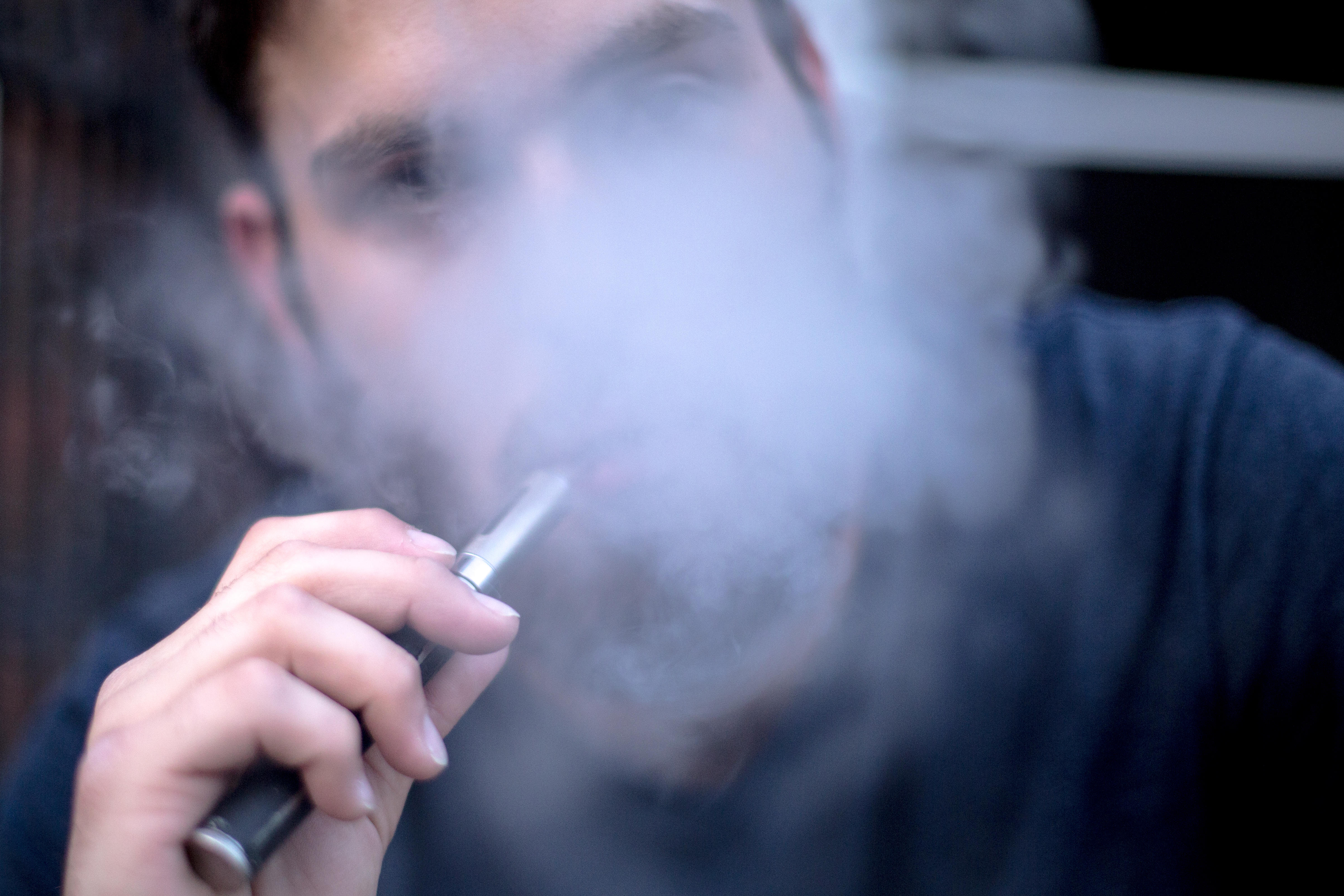 Relaxation and deep breathing can help. It’s also a good idea to reduce your caffeine intake because when you quit smoking your body absorbs almost twice as much caffeine as usual, which can leave you feeling anxious, irritable and restless.
Relaxation and deep breathing can help. It’s also a good idea to reduce your caffeine intake because when you quit smoking your body absorbs almost twice as much caffeine as usual, which can leave you feeling anxious, irritable and restless.

:max_bytes(150000):strip_icc()/ativan-withdrawal-symptoms-4588394_final-6bb2e0e1202b4092ba7297c475a8509f.png)
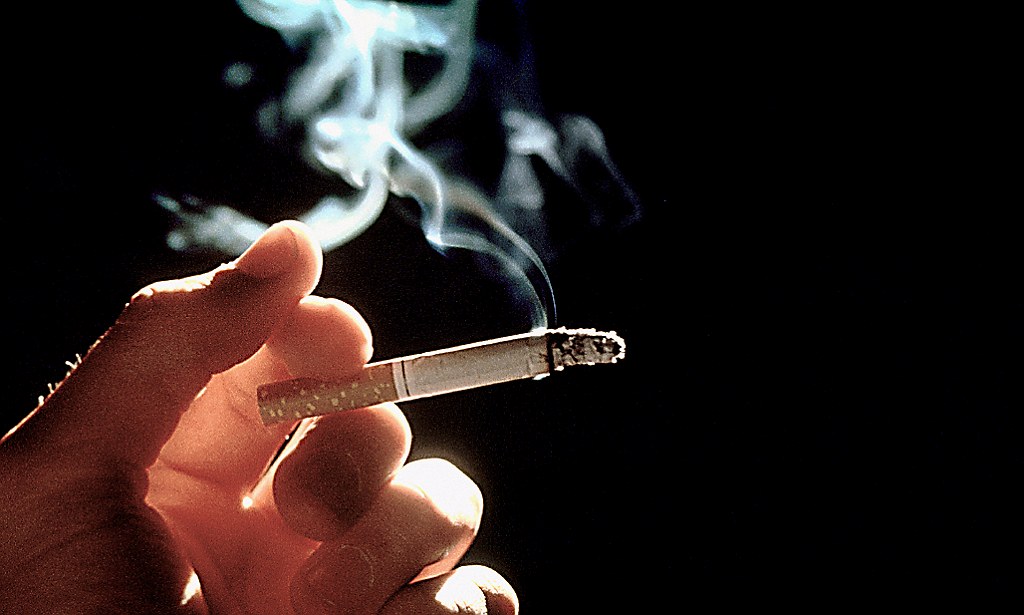 These problems might lead to serious bleeding, early delivery (premature birth), or other problems with the delivery, some of which might require an emergency Caesarean section (C-section).
These problems might lead to serious bleeding, early delivery (premature birth), or other problems with the delivery, some of which might require an emergency Caesarean section (C-section).